Similar presentations:
Strategic Thinking & Creative Problem Solving
1.
Strategic Thinking &Creative Problem Solving
September 11- 13 , 2023
Solving People Issues - is Our Business !
2.
Day 1Strategic Thinking
Day 2
Creative Problem
Solving
Day 3
Strategic Thinking &
Creative problem
Solving
Copyright © 2023| Strive High Pte Ltd.| No part of this content may be circulated, quoted or reproduced for distribution without prior approval | Email info@strive-high.com
3.
OverviewStrategic thinking and its role in modern management
Structure of strategic thinking
Principles of development of strategic thinking
Techniques for the development of strategic thinking: the
development of creativity, the ability to create
unique solutions
Difference between strategic and operational decision
Stages of the creative process of forming innovative solutions
Organizational practices for developing creativity and sharing new
ideas
Analysis of practical case-studies
Copyright © 2023| Strive High Pte Ltd.| No part of this content may be circulated, quoted or reproduced for distribution without prior approval | Email info@strive-high.com
4.
09.30-09.5009.50-10.00
10.00-11.20
REGISTRATION
SEMINAR OPENING
ABIL YERLAN
Rector of the Academy of Public Administration under the President of the Republic of
Kazakhstan
Recognise the skill set of strategic thinkers. Discuss the importance of developing a
big-picture perspective
Interactive discussion. Вrainstorming
11.20-11.40
COFFEE-BREAK
11.40-13.00
Discuss the role of strategic thinking in modern management. Recognise the
difference between strategic decision-making operational decision making.
Interactive discussion. Сase-study
13.00-14.00
LUNCH BREAK
14.00-15.20
Identify your tendencies for fact-based decision making. Identify organisational goals
and the key drivers of stability and success.
Interactive discussion. Small group work
15.20-15.30
BREAK
15.30-16.50
Apply various strategic analysis techniques to analyse current organisational
challenges. Formulate how to overcome barriers to strategic thinking.
Interactive discussion. Practical exercises
5.
Preeti DubeyAwarded: Global Coaching Leader &
Woman Super-achiever, Singapore
Top 100 Entrepreneur, Outstanding
Leadership Award, Education 2.0
(Dubai & USA)
Management Psychologist, Soft Skills
Strategist, Executive Coach, EQ Expert,
Course Developer & Facilitator
• Founder & Director
• STRIVE HIGH Pte. Ltd. - Soft Solutions For Tough
Problems
• Master (Psychology), Masters of Business
Administration
• email : preetidubey@strive-high.com
• Phone : (65) 90679168
• website : www.strive-high.com
• Linkedin : www.linkedin.com/in/dubeypreeti
Copyright © 2023| Strive High Pte Ltd.| No part of this content may be circulated, quoted or reproduced for distribution without prior approval | Email info@strive-high.com
6.
Learning Objectives1. Recognise the skill set of strategic thinkers
2. Discuss the importance of developing a big-picture
perspective
3. Discuss the role of strategic thinking in modern management
4. Recognise the difference between strategic decision-making
operational decision making
5. Identify your tendencies for fact-based decision making
6. Identify organisational goals and the key drivers of stability
and success
7. Apply various strategic analysis techniques to analyse current
organisational challenges.
8. Formulate how to overcome barriers to strategic thinking
Copyright © 2023| Strive High Pte Ltd.| No part of this content may be circulated, quoted or reproduced for distribution without prior approval | Email info@strive-high.com
7.
Day 1Strategic Thinking
“Success is 20% skills and 80% strategy.
You might know how to succeed,
but more importantly,
what’s your plan to succeed?”
— Jim Rohn
Copyright © 2023| Strive High Pte Ltd.| No part of this content may be circulated, quoted or reproduced for distribution without prior approval | Email info@strive-high.com
8.
“Strategy is fundamentally about identifying or creating asymmetric advantages that can beexploited to help achieve one’s ultimate objectives despite resource and other constraints, most
importantly the opposing efforts of adversaries or competitors and the inherent unpredictability
of strategic outcomes.”
-Andrew F. Krepinevich and Barry D. Watts
Copyright © 2023| Strive High Pte Ltd.| No part of this content may be circulated, quoted or reproduced for distribution without prior approval | Email info@strive-high.com
9.
Strategic Thinking,necessary skill for
Public Servants
Professional civil servants need to be
future-oriented and evidence-based.
This requires the acquisition of
strategic skills, particularly at
management levels, to encourage
collaboration between areas of
expertise and across the four parts of
the framework discussed.
Source: OECD Public Governance Reviews Skills for a High
Performing, Civil Service Public sector
Copyright © 2023| Strive High Pte Ltd.| No part of this content may be circulated, quoted or reproduced for distribution without prior approval | Email info@strive-high.com
10.
Meet new peopleFind out 3 things about them
Copyright © 2023| Strive High Pte Ltd.| No part of this content may be circulated, quoted or reproduced for distribution without prior approval | Email info@strive-high.com
11.
Ал, кәне көрейік!Сіздердің қайсыларыңыз 10 нан астам адаммен кездесті?
Қанша адам 5-тен астам адаммен кездесті?
Қанша адам 3 адаммен кездесті?
ЖАҢА адамдарды қалай анықтадыңыз?
Олар туралы қандай жаңа нәрселер білдіңіз?
Жаңа адамдармен танысу жақсы идея деп ойлайсыз ба?
12.
Сіздің стратегияңыз қандай?Стратегия-бұл мақсатқа жету немесе мәселені шешу сияқты
қалаған болашаққа жету үшін жасайтын әдіс немесе
жоспар. Бұл ең тиімді пайдалану үшін қажетті ресурстарды
бағалайтын, сатып алатын және бөлетін жоспар. Бұл
бәсекелестердің реакциясын болжайтын және ескеретін
жоспар.
Copyright © 2023| Strive High Pte Ltd.| No part of this content may be circulated, quoted or reproduced for distribution without prior approval | Email info@strive-high.com
13.
Characteristics of a strategic thinkerCuriosity
Consistency.
Agility
Future focus
Outward
focus
Openness
Breadth
Questioning
Copyright © 2023| Strive High Pte Ltd.| No part of this content may be circulated, quoted or reproduced for distribution without prior approval | Email info@strive-high.com
14.
Attributes of aStrategic Thinker
1. Expand perspective , engage imagination
2. Experience tension, pay attention to things we cannot
control,
3. Develop emotional awareness,
4. Deal with paradox
5. Accept incomplete information
6. Take a risk
7. Learn discipline, appreciate practice,
8. Learn creative process
9. Appreciate practice
10. Desire to win
Copyright © 2023| Strive High Pte Ltd.| No part of this content may be circulated, quoted or reproduced for distribution without prior approval | Email info@strive-high.com
15.
16.
Most VividPersonal brand
and
self-improvement
as mission.
Copyright © 2023| Strive High Pte Ltd.| No part of this content may be circulated, quoted or reproduced for distribution without prior approval | Email info@strive-high.com
17.
Think differentCopyright © 2023| Strive High Pte Ltd.| No part of this content may be circulated, quoted or reproduced for distribution without prior approval | Email info@strive-high.com
18.
SCHWARZKOPF STRATEGY BEHIND DESERT STORMCopyright © 2023| Strive High Pte Ltd.| No part of this content may be circulated, quoted or reproduced for distribution without prior approval | Email info@strive-high.com
19.
We receive three educations,One from our parents,
One from our school-masters,
And
One from the world.
The third contradicts
All that the first two teach us.
—Charles Louis de Secondat, Baron de
Montesquieu (1689–1755),
French political philosopher
Copyright © 2023| Strive High Pte Ltd.| No part of this content may be circulated, quoted or reproduced for distribution without prior approval | Email info@strive-high.com
20.
Why strategicthinking?
• Shifts focus from the past to
the future
• Moves from information to
transformation
• Makes the most of limited
resources
• Enhances the chances of
success
• Gets people on board
• Increases job satisfaction
Copyright © 2023| Strive High Pte Ltd.| No part of this content may be circulated, quoted or reproduced for distribution without prior approval | Email info@strive-high.com
21.
Benefits of strategic thinking•You can chart a course for your group that
aligns with the overall organizational strategy
and execute it in your day-to-day work.
•You can make smart long-term decisions that
complement and align with decisions that
others in your organization are making.
•You gain the commitment of your team to
support your decisions.
•You boost your group’s performance and
maximize business results.
•You focus your daily work so you’re working
on priorities that make the highest
contribution.
Copyright © 2023| Strive High Pte Ltd.| No part of this content may be circulated, quoted or reproduced for distribution without prior approval | Email info@strive-high.com
22.
Becoming a strategicthinker requires:
• Opening mind to possibilities.
• Seeing the bigger picture.
• Understanding the various parts of
your business, taking them apart,
and then putting them back together
again in a more powerful way.
• It’s about insight, invention, emotion
and imagination focused on
reshaping some part of the world.
Copyright © 2023| Strive High Pte Ltd.| No part of this content may be circulated, quoted or reproduced for distribution without prior approval | Email info@strive-high.com
23.
Big Ideas• Big ideas refer to the strategic
intent that the strategy aims to
advance.
• It is this intent that compels us to
think about the future
Copyright © 2023| Strive High Pte Ltd.| No part of this content may be circulated, quoted or reproduced for distribution without prior approval | Email info@strive-high.com
24.
Big Picture ThinkingCopyright © 2023| Strive High Pte Ltd.| No part of this content may be circulated, quoted or reproduced for distribution without prior approval | Email info@strive-high.com
25.
26.
Becoming a strategic thinker is about opening your mindto possibilities.
It’s about seeing the bigger picture. It’s about
understanding the various parts of your business, taking
them apart, and then putting them back together again
in a more powerful way.
It’s about insight, invention, emotion and imagination
focused on reshaping some part of the world.
Frequency: Every problem, every opportunity! Key participants:
You.
Copyright © 2023| Strive High Pte Ltd.| No part of this content may be circulated, quoted or reproduced for distribution without prior approval | Email info@strive-high.com
27.
Source : The Strategy Book Mckeown, MaxCopyright © 2023| Strive High Pte Ltd.| No part of this content may be circulated, quoted or reproduced for distribution without prior approval | Email info@strive-high.com
28.
LookOutside
Look Outside:
1.“What are the fastest growing
trends in the world?
2.What social changes could have
an impact on your company?
3.What are competitors doing?
What are the new normal ways
of doing things?
4.Are you being left behind?
5.Who can you learn from”
Get the Big Idea
-Spot the trends
Look
Inside
Look Inside:
1.Where did the success of the
company come from?
2.What has worked since the
company started?
3.What has failed?
4. What projects have been
attempted? How has the past
led to the situation the
company is in now?
5.What lessons can be learned?
6.What lessons need to be
unlearned?”
Copyright © 2023| Strive High Pte Ltd.| No part of this content may be circulated, quoted or reproduced for distribution without prior approval | Email info@strive-high.com
29.
Exploring the future asone part of the bigger
picture
Copyright © 2023| Strive High Pte Ltd.| No part of this content may be circulated, quoted or reproduced for distribution without prior approval | Email info@strive-high.com
30.
31.
26 жыл ішінде өзгерген Сингапур32.
33.
Helicopter view• Think Big
• Look far
• Utilize the capabilities /
enablers
• Forecast the journey ahead
• Take control
Copyright © 2023| Strive High Pte Ltd.| No part of this content may be circulated, quoted or reproduced for distribution without prior approval | Email info@strive-high.com
34.
Group activity – Big Picture• Make groups based on similar
departments
• Draw the Draw the Big Picture on the
Strategy House
• Identify the Purpose and vision of your
organization.
• Identify the Strategic Intent, Initiatives
and enablers associated with your
department.
• What strategic interest would the
strategic intent serve?
• Choose a spokesperson from your group
to explain your Big Idea
Copyright © 2023| Strive High Pte Ltd.| No part of this content may be circulated, quoted or reproduced for distribution without prior approval | Email info@strive-high.com
35.
Coffee BreakCopyright © 2023| Strive High Pte Ltd.| No part of this content may be circulated, quoted or reproduced for distribution without prior approval | Email info@strive-high.com
36.
StrategyAll men can see these tactics whereby I conquer,
but what none can see is the strategy out of which victory is evolved.
—Sun-tzu (fourth century bc), Chinese military strategist
Copyright © 2023| Strive High Pte Ltd.| No part of this content may be circulated, quoted or reproduced for distribution without prior approval | Email info@strive-high.com
37.
Evolution of Strategic ThinkingCopyright © 2023| Strive High Pte Ltd.| No part of this content may be circulated, quoted or reproduced for distribution without prior approval | Email info@strive-high.com
38.
Shift in the role ofstrategy in the modern
world
1.
Successful strategy reflects both a specific and
a broad context.
2.
Each school of strategy has limitations when
carried to extremes or used in exclusivity.
3.
Across the centuries successful strategy has
proven to be dynamic and generative, not
static and finite.
Copyright © 2023| Strive High Pte Ltd.| No part of this content may be circulated, quoted or reproduced for distribution without prior approval | Email info@strive-high.com
39.
Strategic Thinkingin the VUCA World
• All decisions are about the future. Since the
future is uncertain, all decisions will have an
uncertain outcome.
• But because we’re trying to shape the
future we still need to decide. Part of this is
assessing levels of uncertainty.
• It will require decision making that can give
us the best chance of succeeding despite
uncertainty.
- Mckeown, Max
Copyright © 2023| Strive High Pte Ltd.| No part of this content may be circulated, quoted or reproduced for distribution without prior approval | Email info@strive-high.com
40.
InteractiveDiscussion
In your group discuss following :
1.What are the fastest growing trends in
the world?
2.What social and technological changes
could have an impact on your
organization?
3.What are other similar organizations
doing?
4.What are the new normal ways of doing
things?
5.How has above affected your role and
capabilities?
Copyright © 2023| Strive High Pte Ltd.| No part of this content may be circulated, quoted or reproduced for distribution without prior approval | Email info@strive-high.com
41.
Strategic ThinkingBecoming a strategic thinker requires:
opening mind to possibilities.
Seeing the bigger picture.
Understanding the various parts of your
business, taking them apart, and then
putting them back together again in a
more powerful way.
• It’s about insight, invention, emotion
and imagination focused on reshaping
some part of the world.
Copyright © 2023| Strive High Pte Ltd.| No part of this content may be circulated, quoted or reproduced for distribution without prior approval | Email info@strive-high.com
42.
Think different43.
Strategic ThinkingStrategic thinking is a
problem-focused, intent
driven approach to strategy
based on critical theory and
supported by a complex
cluster of cognitive
capabilities that are distinct
and different from strategic
planning.
Copyright © 2023| Strive High Pte Ltd.| No part of this content may be circulated, quoted or reproduced for distribution without prior approval | Email info@strive-high.com
44.
Thinking before youplan
• Strategy is about out-thinking your
competition.
• It’s about vision first and planning
second. That’s why it’s so important
that you think before you plan.
• And that the thinking part of what
you do is given priority.
• Strategists
Strategists who
who don’t
don’ttake
taketime
timeto
to
think are just
just planners.
planners.
Copyright © 2023| Strive High Pte Ltd.| No part of this content may be circulated, quoted or reproduced for distribution without prior approval | Email info@strive-high.com
45.
Donestrategically is
often better than
operationally
perfect
Copyright © 2023| Strive High Pte Ltd.| No part of this content may be circulated, quoted or reproduced for distribution without prior approval | Email info@strive-high.com
46.
Strategic thinkers askdifferent kinds of questions
and look at old (and new)
problems with fresh eyes.
• Why not change the rules?
• Why do we do what we’re doing?
• Why are we happy (or not) with
the status quo?
• Why not do something
(completely) different?
• Why will our plan work (or fail)?”
Copyright © 2023| Strive High Pte Ltd.| No part of this content may be circulated, quoted or reproduced for distribution without prior approval | Email info@strive-high.com
47.
Contrast of strategic planning and strategic thinkingFactor
Strategic Planning
Strategic Thinking
Intent
Focus on solution
Generate answers
Focus on problem
Suspend solutions
Test for the real and right problem
Concept
A “product” – the plan
Analytical, logical, rational
Linear, sequential, metrics
Conducive to formal learning
Thrives on predictability
Definitive, conclusive
Resolution
Convergent
A “process” – renewable
Re-creative, generative, adaptable
Continuous, ongoing
Anytime/anyplace/anyone
Conducive to informal learning
Insight, innovation, ideas
Thrives on tension, incongruency
Iterative
Divergent
Key
dimensions
Financial
Broad based, financial, innovative, sustainable, social
contribution, individual development, integrity
Copyright © 2023| Strive High Pte Ltd.| No part of this content may be circulated, quoted or reproduced for distribution without prior approval | Email info@strive-high.com
48.
Contrast of strategic planning and strategic thinkingFactor
Strategic Planning
Strategic Thinking
Anchor
Singular, exclusive Economics
Multiple, inclusive Economics, sociology, history,
politics, culture, science, arts, humanities
Formulation
Exclusive
Executive committee
Corporate management team
VPs
Business unit heads
Inclusive
Corporate management teams
“Pipeline” of strategists
Involvement – across, up, and down
Analysis
Quantitative
Neutral
Fixed, static
Objective
Qualitative and quantitative
Subjective and objective
Relationship-based
Dynamic
Contextual
Subjective and objective
Copyright © 2023| Strive High Pte Ltd.| No part of this content may be circulated, quoted or reproduced for distribution without prior approval | Email info@strive-high.com
49.
Shift the focus to Strategic Thinking at the forefrontSource: Learning to Think Strategically, Sloan, Julia
Copyright © 2023| Strive High Pte Ltd.| No part of this content may be circulated, quoted or reproduced for distribution without prior approval | Email info@strive-high.com
50.
Identify which of the following belong toStrategic Thinking and Strategic Planning.
Generative
Rational
Linear
Reductionist
Reflective
Critical
Abstract
Concrete
A-rational
Literal
Polarity
Convergent
Convergent
Divergent
Panoramic
Metaphoric
Intuitive
Objective
Creative
Conceptual
Non-linear
Analytical
Logical
Source: Learning to Think Strategically, Sloan, Julia
Copyright © 2023| Strive High Pte Ltd.| No part of this content may be circulated, quoted or reproduced for distribution without prior approval | Email info@strive-high.com
51.
GrandStrategic
Levels
of War
Institutional
Level of War
Institutional
Strategic
Theater
Strategy
Policy
Strategic
Level of War
Combatant Commands
Operational
Operational
Level of War
Tactical
Tactical
Level of War
Technical
Individuals and Equipment
Copyright © 2023| Strive High Pte Ltd.| No part of this content may be circulated, quoted or reproduced for distribution without prior approval | Email info@strive-high.com
52.
Strategic decisionmaking
• Are taken at top-management level;
• Have a significant impact on resource
allocation;
Identification of
problem
Improvement
Vs Feedback
Strategic
decision
making
• Require irreversible commitments and
hence risk some sunk cost investments;
• Involve major change;
Information
processing
Identification
of options
Implementation
• Are taken under uncertainty / under
incomplete information.
Isolating a
choice
Copyright © 2023| Strive High Pte Ltd.| No part of this content may be circulated, quoted or reproduced for distribution without prior approval | Email info@strive-high.com
53.
Operational Decisions1.
2.
3.
4.
Operational decisions are short-term choices
Primarily concerned with operational details
Sensitive to the changing internal and external
conditions
Operational decisions consist of three steps:
•Input Data
•Decision Logic
•Output or action
Accuracy
Flexibility
Operational
Decisions
Consistency
Timely
Cost-Effective
Copyright © 2023| Strive High Pte Ltd.| No part of this content may be circulated, quoted or reproduced for distribution without prior approval | Email info@strive-high.com
54.
• What is the difference betweenOperational Decisions & Strategic
Decisions?
• What are the Key success factors for
each?
Copyright © 2023| Strive High Pte Ltd.| No part of this content may be circulated, quoted or reproduced for distribution without prior approval | Email info@strive-high.com
55.
Strategic DecisionsOperational Decisions
Copyright © 2023| Strive High Pte Ltd.| No part of this content may be circulated, quoted or reproduced for distribution without prior approval | Email info@strive-high.com
56.
Стратегиялық шешімдерЖедел шешімдер
Әкімшілік шешімдер
Ұзак мерзімді
Жиі қолданылмау
Күн сайын қабылдану
Болашақты жоспарлау
Орта мерзімді кезеңге негізделген
шешімдер
Қысқа мерзімді шешімдер
Ұйымның миссиясы мен көзқарасына
сәйкес
Стратегиялық және әкімшілік шешімге
сәйкес қабылдану
Стратегиялық және жедел
шешімдерге сәйкес қабылдану
Ұйымның жалпы жоспарлауымен
байланысты
Өндіріске байланысты
Ұйымдағы қызметкерлердің
жұмысына байланысты
Ұйымдастырушылық өсу мәселелерімен
айналысады
Өндіріс пен бөлімнің өсуіне байланысты
Бұл ұйымда жұмыс істейтін
қызметкерлердің әл-ауқатына
қатысты
Copyright © 2023| Strive High Pte Ltd.| No part of this content may be circulated, quoted or reproduced for distribution without prior approval | Email info@strive-high.com
57.
Group Share• Think about a recent operational situation or event that did not go as
expected.
• It should be an event you were personally involved in rather than one you
heard about second-hand.
• This situation can be where the outcome was worse than expected or
things turned out better.
• The situation should be vivid enough in your memory to recall specific
details.
• Make sure you select an event that you will feel comfortable sharing.
• Spend 10- minutes thinking about what contributed to the situation
unfolding in the way it did.
• Take turns describing the situation or event you reflected on to the other
small group and identify if the decisions were Operational in nature.
• How many of your decisions were based on facts and how many on
intuition and imagination?
Copyright © 2023| Strive High Pte Ltd.| No part of this content may be circulated, quoted or reproduced for distribution without prior approval | Email info@strive-high.com
58.
Exercise Debrief• How has your understanding of the
situation changed?
• Are there particular aspects of the
situation that you now understand
more clearly?
• What have you learned or become
aware of that hadn’t occurred to
you before?
Copyright © 2023| Strive High Pte Ltd.| No part of this content may be circulated, quoted or reproduced for distribution without prior approval | Email info@strive-high.com
59.
Lunch BreakCopyright © 2023| Strive High Pte Ltd.| No part of this content may be circulated, quoted or reproduced for distribution without prior approval | Email info@strive-high.com
60.
Though this be madness,yet there is method in it.
—William Shakespeare (1564–1616)
Copyright © 2023| Strive High Pte Ltd.| No part of this content may be circulated, quoted or reproduced for distribution without prior approval | Email info@strive-high.com
61.
Strategic ThinkingRequires
To collect data and information from internal and
external sources, and use the right tools to help
you understand:
• What really happens in your organization and
environment
• What are the possibilities, and
• What you need to focus on
Copyright © 2023| Strive High Pte Ltd.| No part of this content may be circulated, quoted or reproduced for distribution without prior approval | Email info@strive-high.com
62.
Goals• Goals give strategy purpose and direction
• The goals of a strategy may be expressed in either vague or very specific terms.
• Must advance the interests of the organization
• Goals should be stated in clear and unambiguous terms so as to point to either
success or failure of the strategy.
• A primary Goal can be a general goal to provide strategic focus on a singular,
overarching objective, which encompasses the entire organization. Subsidiary
goals are more measurable and specific, while primary goals may be broader
and more sweeping.
• Focus on utilizing the capabilities imaginatively without getting your view
obstructed by the scarcity of resources to achieve outsized goals.
Copyright © 2023| Strive High Pte Ltd.| No part of this content may be circulated, quoted or reproduced for distribution without prior approval | Email info@strive-high.com
63.
Case Study – Goal AnalysisDuring the U.S. military engagement in Iraq, which commenced in 2003, In a post 9/11 environment, when
the perceived threat was high, the overriding core interests of the United States were national security and
protection of the homeland.
In 2003, the most immediate goal for Iraq was the toppling of Saddam Hussein’s regime. There were other
goals as well, such as discovery and elimination of weapons of mass destruction and replacing Saddam’s
regime with a more benign leadership.4”
It could be argued, however, that successful attainment of the regime change goal undermined rather than
advanced the U.S. interest of national security. While the US achieved the goal of toppling the regime, this
victory produced the unintended consequence of an unraveling of the Iraqi state apparatus and a slide
towards civil war. What had been a strong state quickly turned into a struggling, fragile state—an outcome
with the potential to undermine U.S. national security interests. The resulting chaos and instability facilitated
the creation of a fresh base from which al-Qaeda could wage battle against the United States.
Did the achievement of the goal serve the national security interests of the United States?
Copyright © 2023| Strive High Pte Ltd.| No part of this content may be circulated, quoted or reproduced for distribution without prior approval | Email info@strive-high.com
64.
Coffee BreakCopyright © 2023| Strive High Pte Ltd.| No part of this content may be circulated, quoted or reproduced for distribution without prior approval | Email info@strive-high.com
65.
Major Civil ServicesReforms in
Kazakhstan
• Source : OECD Public Governance Reviews
• Benchmarking Civil Service Reform in Kazakhstan
Copyright © 2023| Strive High Pte Ltd.| No part of this content may be circulated, quoted or reproduced for distribution without prior approval | Email info@strive-high.com
66.
TheInternational
Civil Service
Effectiveness
(InCiSE)
Framework
Source The International Civil
Service Effectiveness Index pdf
67.
2020 жылға арналған стратегиялық жоспарҚазақстан Республикасының 2020 жылға дейінгі 2020 жылға дейінгі Стратегиялық жоспарды іске асыру
нәтижесінде Қазақстан мынадай түйінді көрсеткіштерге қол
кезеңге арналған стратегиялық даму жоспары
жеткізуі тиіс:
• Дағдарыстан кейінгі дамуға дайындық;
2020
жылға
қарай
Қазақстан
ел
экономикасының
• Индустрияландыру және инфрақұрылымды
емес
секторларына
елеулі
шетелдік
дамыту есебінен жеделдетілген әртараптандыру шикізаттық
жолымен
экономиканың
тұрақты
өсуін инвестицияларды тартуға мүмкіндік беретін қолайлы
іскерлік ахуалы бар әлемнің бәсекеге барынша қабілетті
қамтамасыз ету;
елу елінің қатарына енеді.
• Болашаққа
инвестициялар
Қазақстандықтардың тұрақты экономикалық • 2020
жылға
қарай
елде
әртараптандырылған
өсуіне, өркендеуіне және әлеуметтік әлэкономиканы дамыту үшін қажетті адами ресурстарға,
ауқатына қол жеткізу үшін адами капиталдың
сондай-ақ отандық кәсіпкерлер мен экспорттаушыларға
бәсекеге қабілеттілігін арттыру;
қызмет көрсету үшін қажетті инфрақұрылымға ие
• Халықты сапалы әлеуметтік және тұрғын үйкоммуналдық қызметтермен қамтамасыз ету;
• Халықаралық
халықаралық
нығайту;
келісімді,
қатынастардың
болады.
• 2020 жылға қарай Қазақстан экономикасы нақты алғанда
қауіпсіздікті,
2009 жылғы деңгейге қарағанда үштен бірінен астамға
тұрақтылығын
ұлғаяды.
• Ұлтаралық келісімді, қауіпсіздікті, халықаралық
қатынастардың тұрақтылығын нығайту.
• 2020 жылға қарай төменгі күнкөріс мөлшерінен аз табыс
табатын халықтың үлесі 8% - ға дейін төмендейді.
Дереккөз : https://www.akorda.kz/en/official_documents/strategies_and_programs
68.
«Қазақстан-2030» даму стратегиясы ұзақ мерзімді жетібасымдықты іске асыруды көздейді :
• Ұлттық қауіпсіздік.
• Ішкі саяси тұрақтылық және қоғамның топтасуы.
• Шетел инвестициялары мен ішкі жинақталымдардың жоғары деңгейі бар
ашық нарықтық экономикаға негізделген экономикалық өсу.
• Қазақстан азаматтарының денсаулығы, білімі және әл-ауқаты.
• Энергетика ресурстары.
• Инфрақұрылым, атап айтқанда көлік және байланыс.
• Кәсіби мемлекет.
Дереккөз:https://www.akorda.kz/en/official_documents/strategies_and_progra
ms
69.
Қазақстан – 2030 Стратегиясы2012 жылғы желтоқсанда Мемлекет басшысы өзінің Қазақстан
халқына Жолдауында Қазақстан Республикасының 2050 жылға
дейінгі даму Стратегиясын ұсынды. Стратегияның басты мақсатымықты мемлекетке, жалпыға бірдей жұмыспен қамту мүмкіндіктері
бар дамыған экономикаға негізделген әл-ауқат қоғамын құру,
сондай-ақ әлемнің ең дамыған 30 елінің қатарына кіру.
Дереккөз: https://www.akorda.kz/en/official_documents/strategies_and_programs
70.
Қазақстан-2050 стратегиясы ұзақ мерзімді жетібасымдықтарды іске асыруда қарастырады:
1.
2.
3.
4.
5.
6.
7.
Жаңа бағыттың экономикалық саясаты - бұл пайда алу, инвестициялардың
қайтарымы және бәсекеге қабілеттілік принциптеріне негізделген жан-жақты
экономикалық прагматизм.
Кәсіпкерлікті жан – жақты қолдау –ұ лттық экономикадағы жетекші күш.
Әлеуметтік саясаттың жаңа принциптері - әлеуметтік кепілдіктер және жеке
жауапкершілік.
Білім мен кәсіби машық - қазіргі заманауи білім беру жүйесінің, кадрларды
кәсіптік даярлау мен қайта даярлаудың негізгі бағдарлары болып табылады.
Мемлекеттілікті одан әрі нығайту және қазақстандық демократияны дамыту.
Дәйекті және болжамды сыртқы саясат-ұлттық мүдделерді ілгерілету және
аймақтық және жаһандық қауіпсіздікті нығайту.
Жаңа қазақстандық патриотизм - біздің көпұлтты және көпконфессиялы
қоғамымыздың табысының негізі.
Дереккөз: https://www.akorda.kz/en/official_documents/strategies_and_programs
71.
21 ғасырдағы он жаһандық сын-қатер1. Бірінші сын-қатер - тарихи уақыттың жеделдеуі
2. Екінші сын-қатер - жаһандық демографиялық теңгерімсіздік
3. Үшінші сын-қатер - жаһандық азық-түлік қауіпсіздігіне қауіп төнетін
қатер
4. Төртінші сын-қатер - су тапшылығы
5. Бесінші сын-қатер - жаһандық энергетикалық қауіпсіздік
6. Алтыншы сын-қатер -табиғи ресурстардың сарқылуы
7. Жетінші сын-қатер - үшінші өнеркәсіптік революция
8. Сегізінші сын-қатер – үдей түскен әлеуметтік тұрақсыздық
9. Тоғызыншы сын-қатер - өркениетіміз құндылықтарының дағдарысы
10. Оныншы сын-қатер - жаңа әлемдік тұрақсыздық қаупі
Source: https://www.akorda.kz/en/official_documents/strategies_and_programs
72.
What is Your Organization'sStrategy?
Step 1: Gather Information About Strategic Objectives
• Review any strategy documentation that your
organization, department, or team may have.
Step 2: Analyse Risk in Strategic Objectives
• What are the major sources of uncertainty in your team’s
future?
• What external risks can you identify? Think about
categories like funding; competition and conflict with
other units in the company; the status of your patrons or
protectors within the company; and potential
reorganization.
• What internal risks can you identify? Consider upcoming
personnel changes, team dynamics, and office politics.
Copyright © 2023| Strive High Pte Ltd.| No part of this content may be circulated, quoted or reproduced for distribution without prior approval | Email info@strive-high.com
73.
Identify signals of internal changePeople
Process
Turnover
Power dynamics
Engagement
Key process / Technology
Patterns in requests from stakeholders
Change in services
Products / Services
Strategy
New services , Responsibilities, Roles
Changes in resource allocation
Changes in stakeholder priorities
Copyright © 2023| Strive High Pte Ltd.| No part of this content may be circulated, quoted or reproduced for distribution without prior approval | Email info@strive-high.com
74.
Five questions for yourKey stakeholders
1.
Does the stakeholder have a fundamental impact on
your organization’s performance?
2.
Can you clearly identify what you want from the
stakeholder?
3.
Is the relationship dynamic—that is, do you want it to
grow?
4.
Can you exist without or easily replace the stakeholder?
5.
Has the stakeholder already been identified through
another relationship?
Copyright © 2023| Strive High Pte Ltd.| No part of this content may be circulated, quoted or reproduced for distribution without prior approval | Email info@strive-high.com
75.
SWOTAnalysis
Copyright © 2023| Strive High Pte Ltd.| No part of this content may be circulated, quoted or reproduced for distribution without prior approval | Email info@strive-high.com
76.
Case StudyCurrent focus of the Reform in following problem
areas:
1. lack of proper interaction between citizens and
the state;
2. insufficient effectiveness of strategic planning
and reform approaches;
3. functions of the state apparatus that are not
focused on the needs of the population and
business;
4. administrative nature of public services;
5. uncompetitive public service;
6. inefficient quasi-public sector;
7. undeveloped local government;
8. excessive regulation that hinders business
development;
9. the low level of citizens' trust in the judicial and
law enforcement systems.
Section 4. Basic principles of public administration
4.1. The principle of the "Hearing State"
4.2. The principle of an effective State
4.3. The principle of an accountable State
4.4. The principle of the professional State
4.5. The principle of a pragmatic State
Tasks identified for National priority 5. to develop a
new model of public administration
Task 1. An integrated approach to the effectiveness of
public administration
Task 2. Formation of a service and "human-centered"
model of public administration
Task 3. Open Government
Task 4. Increasing the focus on results and the
interests of citizens
Copyright © 2023| Strive High Pte Ltd.| No part of this content may be circulated, quoted or reproduced for distribution without prior approval | Email info@strive-high.com
77.
Президент Қасым-Жомарт Тоқаевтың «ӘділҚазақстанның экономикалық бағыты» атты
Қазақстан халқына Жолдауы
https://www.akorda.kz/en/president-kassymjomart-tokayevs-state-of-the-nation-addresseconomic-course-of-a-just-kazakhstan-283243
78.
Group Activity – SWOT AnalysisStrengths
Weaknesses
• What do we do well?
• What have our stakeholders told us
they like about us?
• What's unique about our services?
• What assets do we own
(Intellectual property, proprietary
technology)?
Opportunities
Threats
•What emerging trends can we take
advantage of?
•Which of our strengths might be
valuable to potential partners?
•What adjacent markets might we tap
into?
•Are there any geographic locations we
can take advantage of?
•How could our weaknesses leave us
vulnerable?
•What market trends are we
unprepared for?
•What economic or political issues
could impact our business?
What can we improve?
What are our stakeholders
dissatisfied with?
Where are we falling behind?
Where are we lacking in knowledge
or resources?
Copyright © 2023| Strive High Pte Ltd.| No part of this content may be circulated, quoted or reproduced for distribution without prior approval | Email info@strive-high.com
79.
Activity SWOT Analysis –Report
Instructions : Think hard and imaginatively about the whole organization and its external
context
1.
Consider the links between the four boxes. What strengths will allow you to take advantage
of opportunities or overcome threats?
2.
List all the weaknesses that need to be addressed to benefit from them?
3.
Prioritize your lists by looking at their relative impact and probability.
4.
Turn prioritized lists into specific strategies (or plans) with tentative timelines and
ownership.
Copyright © 2023| Strive High Pte Ltd.| No part of this content may be circulated, quoted or reproduced for distribution without prior approval | Email info@strive-high.com
80.
DifferentiatingBasic
Matrix of individual competencies for positions of different levels
The level of positions of administrative civil servants of the Republic of Kazakhstan
Competencies
Level "D"
Level "C"
Level "B"
Level "A"
1
2
3
4
5
6
7
8
9
10 11 12 13 14 15
System management
Change Management
Strategic thinking
Leadership
Decision making
Activity management
Cooperation and
interaction
Efficiency
Self-development
Integrity
Orientation to the
consumer of services and
informing him
Responsibility
Initiative
Stress resistance
81.
What role can you playin your Organization's
Strategy?
Step 3: Analyse your role and risk
• Are there any major sources of uncertainty in your
future?
• What are professional risks to your success?
• What are personal risks to your success?
Copyright © 2023| Strive High Pte Ltd.| No part of this content may be circulated, quoted or reproduced for distribution without prior approval | Email info@strive-high.com
82.
Five Attributes forStrategic Thinking
1.
Having a vivid imagination
2.
Keeping a broad perspective
3.
Being able to juggle, or attend to
competing, incomplete, and inaccurate
information all at once
4.
Dealing with things over which you have
no control
5.
Possessing an adamant and relentless
desire to win.
Source: Learning to Think Strategically, Sloan, Julia
Copyright © 2023| Strive High Pte Ltd.| No part of this content may be circulated, quoted or reproduced for distribution without prior approval | Email info@strive-high.com
83.
Barriers toStrategic Thinking
1. Habit
2. Unconscious Bias
3. Assumptions
4. Too much information
5. Tyranny of the urgent
Copyright © 2023| Strive High Pte Ltd.| No part of this content may be circulated, quoted or reproduced for distribution without prior approval | Email info@strive-high.com
84.
Overcome the Barriersto Strategic Thinking
1.
Expand perspective
2.
Engage in imagination
3.
Experience tension
4.
Pay attention to things we cannot control
5.
Develop emotional awareness
6.
Deal with paradox
7.
Accept incomplete information
8.
Take a risk
9.
Learn discipline
10. Appreciate practice
Copyright © 2023| Strive High Pte Ltd.| No part of this content may be circulated, quoted or reproduced for distribution without prior approval | Email info@strive-high.com
85.
The best way topredict your future
is create it.
- Abraham Lincoln
Copyright © 2023| Strive High Pte Ltd.| No part of this content may be circulated, quoted or reproduced for distribution without prior approval | Email info@strive-high.com
86.
ActivityChallenge
Create your personal action plan to
become a strategic thinker
Action
Plan
Focus
Actions
Copyright © 2023| Strive High Pte Ltd.| No part of this content may be circulated, quoted or reproduced for distribution without prior approval | Email info@strive-high.com
87.
Day 1Strategic Thinking
Day 2
Creative Problem
Solving
Day 3
Strategic Thinking &
Creative problem
Solving
Copyright © 2023| Strive High Pte Ltd.| No part of this content may be circulated, quoted or reproduced for distribution without prior approval | Email info@strive-high.com
88.
10.00-11.2011.20-11.40
11.40-13.00
13.00-14.00
14.00-15.20
15.20-15.30
15.30-16.50
Critical Thinking versus Creative Thinking. Recognising Creative Principles.
Interactive discussion. Practical exercises
COFFEE-BREAK
Reframing the Mind – Understanding and Changing our Perceptions. Use
various creative thinking techniques to assist in a more creative and
innovative approach to problem exploration and
idea generation.
Interactive discussion. Group work
LUNCH BREAK
Discuss strategies for releasing a flow of original ideas. Appreciate the
importance of creative thinking and innovation.
Interactive discussion. Small group work
BREAK
Understand the tools needed for creative thinking and innovation. Identify
and overcome barriers to creative thinking and innovation.
Consolidation of material. Group work
89.
Do not be bound by this age;aim to create a new age.
- Masayoshi son, CEO of Softbank, entrepreneur,
investor and philanthropist
Copyright © 2023| Strive High Pte Ltd.| No part of this content may be circulated, quoted or reproduced for distribution without prior approval | Email info@strive-high.com
90.
91.
Creativity is good for theeconomy
The creative economy is thriving,
according to the UN Conference on Trade
and Development (UNCTAD) Creative
Economy Outlook report 2018. Between
2002 and 2015, the global market for
creative goods – dominated by design,
fashion and film – has more than doubled
in size, from $208 billion to $509 billion.
Copyright © 2023| Strive High Pte Ltd.| No part of this content may be circulated, quoted or reproduced for distribution without prior approval | Email info@strive-high.com
92.
Change with the changing timesThinking is the hardest work there is, which is probably why so few engage in it.
- Henry ford, Founder of the ford motor company
Copyright © 2023| Strive High Pte Ltd.| No part of this content may be circulated, quoted or reproduced for distribution without prior approval | Email info@strive-high.com
93.
Activity - Icebreaker• Think of the most creative
discoveries?
• What is so special about them?
Copyright © 2023| Strive High Pte Ltd.| No part of this content may be circulated, quoted or reproduced for distribution without prior approval | Email info@strive-high.com
94.
Quality of ideasSource: John Adair
Copyright © 2023| Strive High Pte Ltd.| No part of this content may be circulated, quoted or reproduced for distribution without prior approval | Email info@strive-high.com
95.
NASA Creativity TestCopyright © 2023| Strive High Pte Ltd.| No part of this content may be circulated, quoted or reproduced for distribution without prior approval | Email info@strive-high.com
96.
CriticalThinking &
Creative
Thinking
Copyright © 2023| Strive High Pte Ltd.| No part of this content may be circulated, quoted or reproduced for distribution without prior approval | Email info@strive-high.com
97.
Common Thinking Errors• Selective thinking: The tendency to validate
certain ideas and discount others
• Reactive thinking: The tendency to react to
existing influences, events or ideas, often
too quickly.
• Assumptive thinking: The tendency to
accept a belief, convention or idea as true,
often with no proof
Copyright © 2023| Strive High Pte Ltd.| No part of this content may be circulated, quoted or reproduced for distribution without prior approval | Email info@strive-high.com
98.
Creativity, as has been said,consists largely of rearranging what we know
in order to find out what we do not know.
Hence, to think creatively,
we must be able to look afresh at
what we normally take for granted.
- George Kneller
Author of the art and science of creativity
(1965)
Copyright © 2023| Strive High Pte Ltd.| No part of this content may be circulated, quoted or reproduced for distribution without prior approval | Email info@strive-high.com
99.
Difference between - Creativity & InnovationCreativity - The incubator and cultivator of new ideas, which are born from existing
knowledge and combined to form a new neural pathway in the brain, leading to a personal
original thought
Innovation - is the whole package – creative and logical thinking combined to produce
something meaningful and take ideas forward. In this sense, innovation is a connected
process in which many activities come together to bring an idea to fruition
-Griffiths Chris
Innovation is not the product of logical thought,
Although the result is tied to logical structure.
- Albert Einstein
Copyright © 2023| Strive High Pte Ltd.| No part of this content may be circulated, quoted or reproduced for distribution without prior approval | Email info@strive-high.com
100.
The order of creative thinking• Generative / Imaginative Stage –Marked by
Divergent Thinking. Allow thoughts to diverge or
go in different directions.
• Analytical/ Practical Stage – Marked by Convergent
Thinking – the idea is to force your thoughts to
converge, to make them come together to a single
point
Generative
Analytical
• Selective / Action Stage - Involves generating
recommendations, setting goals, testing the
solution and preparing to carry it into action.
Creativity can solve almost any problem.
The creative act, the defeat of habit by originality, overcomes everything.
George Lois, American art director, designer and author
Copyright © 2023| Strive High Pte Ltd.| No part of this content may be circulated, quoted or reproduced for distribution without prior approval | Email info@strive-high.com
Selective
101.
Group Activity –Create a Pictionary
• In your Group
• Catch all the Creative Ideas that
come to your mind on of the
challenges you identified
yesterday
• Create a Pictionary by drawing
them on the Flip Chart
If everyone is thinking alike, then somebody
isn’t thinking.
George S Patton , General in the united states
army during WWII
Copyright © 2023| Strive High Pte Ltd.| No part of this content may be circulated, quoted or reproduced for distribution without prior approval | Email info@strive-high.com
102.
Coffee BreakCopyright © 2023| Strive High Pte Ltd.| No part of this content may be circulated, quoted or reproduced for distribution without prior approval | Email info@strive-high.com
103.
Activity - Months ofthe year
• Recite the months of the year as fast
as you can.
• Now list the months again, this time
alphabetically.
Copyright © 2023| Strive High Pte Ltd.| No part of this content may be circulated, quoted or reproduced for distribution without prior approval | Email info@strive-high.com
104.
Concept Drivershttps://historycollection.com/23-photos-wright-brothers-flights/
Copyright © 2023| Strive High Pte Ltd.| No part of this content may be circulated, quoted or reproduced for distribution without prior approval | Email info@strive-high.com
105.
Copyright © 2023| Strive High Pte Ltd.| No part of this content may be circulated, quoted or reproduced for distribution without prior approval | Email info@strive-high.com106.
Star Trek – Sci Fi107.
Sources of Creativity1.
Innocence
2.
Experience
3.
Motivation
4.
Tuned Judgement
5.
Chance, accident mistake and madness
6.
Style
7.
Release
Source - Edward De Bono
Copyright © 2023| Strive High Pte Ltd.| No part of this content may be circulated, quoted or reproduced for distribution without prior approval | Email info@strive-high.com
108.
Sources ofCreativity
1. Innocence
If you don’t ask, ‘Why this?’ often enough,
Someone else will ask, ‘Why you?’
Tom Hirshfield, American research physicist
Copyright © 2023| Strive High Pte Ltd.| No part of this content may be circulated, quoted or reproduced for distribution without prior approval | Email info@strive-high.com
109.
Sources ofCreativity
2. Experience
Creativity, as has been said, consists largely of rearranging
what we know in order to find out what we do not know.
Hence, to think creatively, we must be able to look afresh
at what we normally take for granted.
-George Kneller, Author of the art and science of creativity
(1965)
Copyright © 2023| Strive High Pte Ltd.| No part of this content may be circulated, quoted or reproduced for distribution without prior approval | Email info@strive-high.com
110.
Sources ofCreativity
3. Motivation
Information overload is a symptom of our
desire to not focus on what’s
important. It’s a choice.
- Brian Solis, American Industry Analyst
Copyright © 2023| Strive High Pte Ltd.| No part of this content may be circulated, quoted or reproduced for distribution without prior approval | Email info@strive-high.com
111.
Sources ofCreativity
4. Tuned Judgement
Begin challenging your own assumptions.
Your assumptions are your windows on
the world.
Scrub them off every once in a while,
or the light won’t come in.
Alan Alda, American actor, (1980)
Copyright © 2023| Strive High Pte Ltd.| No part of this content may be circulated, quoted or reproduced for distribution without prior approval | Email info@strive-high.com
112.
Sources ofCreativity
5. Chance, accident mistake
and madness
Source - Edward De Bono
If you’re proactive, you focus on preparing.
If you’re reactive, you end up focusing on repairing.
- John C Maxwell, bestselling author and motivational speaker
Copyright © 2023| Strive High Pte Ltd.| No part of this content may be circulated, quoted or reproduced for distribution without prior approval | Email info@strive-high.com
113.
Sources ofCreativity
6. Style
Nothing is more dangerous than an idea
when it’s the only one we have.
Emile Chartier, French Philosopher
Copyright © 2023| Strive High Pte Ltd.| No part of this content may be circulated, quoted or reproduced for distribution without prior approval | Email info@strive-high.com
114.
Sources ofCreativity
7. Release
You can’t use up creativity,
the more you use,
the more you have.
- Maya Angelou, poet,
singer and civil rights activist
Copyright © 2023| Strive High Pte Ltd.| No part of this content may be circulated, quoted or reproduced for distribution without prior approval | Email info@strive-high.com
115.
Why Creativethinking?
• Improvement
• Problem Solving
• Value & Opportunity
• The Future
• Motivation
Copyright © 2023| Strive High Pte Ltd.| No part of this content may be circulated, quoted or reproduced for distribution without prior approval | Email info@strive-high.com
116.
Creative Thinking Techniques– Lateral Thinking
Vertical /Analytical
Thinking
Lateral /Creative
Thinking
Copyright © 2023| Strive High Pte Ltd.| No part of this content may be circulated, quoted or reproduced for distribution without prior approval | Email info@strive-high.com
117.
Six Thinking Hats - Edward De BonoInformation
• We have?
• Missing?
• Like to have?
• How to get?
Feelings
• How do I feel?
• My gut feeling?
• Do you like it?
Caution
• Regulatory
permission?
• Have capacity?
• Capability?
• Past history?
Optimism
• Positive?
• Feasible?
• Benefit?
Creative
• New Ideas?
• Additional
ideas?
• See
differently?
• Alternative
Point of view?
Process
Control
• Agenda/
• Next steps?
• Other hats?
• Summary &
conclusion?
• Priorities?
Source : Serious Creativity Edward De Bono
Copyright © 2023| Strive High Pte Ltd.| No part of this content may be circulated, quoted or reproduced for distribution without prior approval | Email info@strive-high.com
118.
Navigate through thebarriers with the 6 Hats
• Arguments
• Ego & Performance
• Persistent Negativity
• Encourage Positive & Creative thinking
• Participation
• Avoid rigidity with Cap Switching
• Systematic use
Source : Serious Creativity Edward De Bono
Copyright © 2023| Strive High Pte Ltd.| No part of this content may be circulated, quoted or reproduced for distribution without prior approval | Email info@strive-high.com
119.
Creative Pause• Creative pause” is a deliberate
process.
• It is not the result of some
sudden inspiration that has to be
followed through.
• You pause because you want to.
• You pause in order to make a
creative effort.
• You have the intention of being
creative.
Source : Serious Creativity Edward De Bono
Copyright © 2023| Strive High Pte Ltd.| No part of this content may be circulated, quoted or reproduced for distribution without prior approval | Email info@strive-high.com
120.
Creative FocusSimple Focus
• The simple focus is a deliberate effort to pick
out a new focus point against the creative
pause, which is the willingness to pause during
some thinking or discussion to pay creative
attention.
• List of possible focus points
• Preliminary attempt to generate alternatives
• Generate ideas in defined focus area
Source : Serious Creativity Edward De Bono
Copyright © 2023| Strive High Pte Ltd.| No part of this content may be circulated, quoted or reproduced for distribution without prior approval | Email info@strive-high.com
121.
Creative Focus• Specific Focus
o Everyday creativity – creativity as a part of a person’s
thinking skill
o Specific focus – defined by an individual or group.
• General-area focus we simply define the general
area in which we want some new ideas.
• Purpose focus
o Problem Solving
o Task
o Opportunity
Source : Serious Creativity Edward De Bono
Copyright © 2023| Strive High Pte Ltd.| No part of this content may be circulated, quoted or reproduced for distribution without prior approval | Email info@strive-high.com
122.
Focus Occasions• Defined need or purpose
• Routine review
• Idea-sensitive point
• Whim
Source : Serious Creativity Edward De Bono
Copyright © 2023| Strive High Pte Ltd.| No part of this content may be circulated, quoted or reproduced for distribution without prior approval | Email info@strive-high.com
123.
CreativeChallenge
• The Power of WHY, What and
How?
• The creative challenge simply
refuses to accept that the
current way is necessarily the
best way. The creative challenge
assumes that the current way is
just one way which happens to
be there for a variety of reasons.
Copyright © 2023| Strive High Pte Ltd.| No part of this content may be circulated, quoted or reproduced for distribution without prior approval | Email info@strive-high.com
124.
CreativeChallenge
examples
125.
Adversity orOpportunity?
• Are there new problems that can become
unplanned opportunities?
• Does this problem let us start again and do it
better?
• What can we do today that was impossible
yesterday?
• Is our plan still working? How can we take
advantage of events?
Copyright © 2023| Strive High Pte Ltd.| No part of this content may be circulated, quoted or reproduced for distribution without prior approval | Email info@strive-high.com
126.
Activity Creative Focus& Challenge
• Refer to your Big Picture and SWOT Analysis
worksheet and identify the following from
different perspectives using the 6 Thinking Hats. .
• Identify the Creative Focus
• Define the Creative Challenge
The greatest challenge to any thinker is
stating the problem in a way that will allow a solution.
- attributed to Bertrand Russell,
British Philosopher and Logician
Copyright © 2023| Strive High Pte Ltd.| No part of this content may be circulated, quoted or reproduced for distribution without prior approval | Email info@strive-high.com
127.
Lunch BreakCopyright © 2023| Strive High Pte Ltd.| No part of this content may be circulated, quoted or reproduced for distribution without prior approval | Email info@strive-high.com
128.
The brain is a wonderful organ. It starts workingthe moment you get up in the morning,
and doesn’t stop until
you get to the office.
- Attributed to Robert Frost
Copyright © 2023| Strive High Pte Ltd.| No part of this content may be circulated, quoted or reproduced for distribution without prior approval | Email info@strive-high.com
129.
Create the Idea FlowUnderstanding
• Define the
Challenge
Ideation
Analysis
• Generate
Idea
• Evaluate
Idea
Direction
• Implement
the Solution
Source : Chris Griffiths , 2022
Copyright © 2023| Strive High Pte Ltd.| No part of this content may be circulated, quoted or reproduced for distribution without prior approval | Email info@strive-high.com
130.
Understanding ToolkitInput
Presented
Challenge
Process
Examine the
brief and
define the
challenge in
detail
Tools
• Define and
Understand
Canvas
• 5W1H Canvas
• Changing
Perspectives
Canvas
Output
Challenge
clearly
defined
Source : Chris Griffiths , 2022
Copyright © 2023| Strive High Pte Ltd.| No part of this content may be circulated, quoted or reproduced for distribution without prior approval | Email info@strive-high.com
131.
Understanding – Define & Understand CanvasState challenge or problem
Initial Opinion & Thoughts
Ideal Outcomes
Boundaries & Limitations
Restate Reframe Challenges
Acceptable Outcomes
What we Know (Facts Only)
What we think we know (Facts Only)
What we need to know (Research)
Source : Chris Griffiths , 2022
Copyright © 2023| Strive High Pte Ltd.| No part of this content may be circulated, quoted or reproduced for distribution without prior approval | Email info@strive-high.com
132.
Understanding - Explore 5 W 1 HWhat?
What are the facts?
What is my goal or purpose?
Why?
Why does the challenge exist?
Ask why five times?
1
Where?
Where can I best solve?
Who?
Who can help?
Who will benefit?
When?
When is the deadline?
How?
How does it affect people or activities?
How did it evolve?
2
3
4
Source : Chris Griffiths , 2022
Copyright © 2023| Strive High Pte Ltd.| No part of this content may be circulated, quoted or reproduced for distribution without prior approval | Email info@strive-high.com
133.
Changing Perspectives CanvasState challenge or problem
What would I do if I had no fear?
How would the following people you identify find a
solution to the challenge?
Person 1 _____________
What do I need to do differently to find the solution?
Person 2 _____________
Person 3 _____________
What do I want to say about how I handled this
challenge one year from now?
Person 4 _____________
Source : Chris Griffiths , 2022
Copyright © 2023| Strive High Pte Ltd.| No part of this content may be circulated, quoted or reproduced for distribution without prior approval | Email info@strive-high.com
134.
Understanding ChecklistDo’s
Don’t
identify the real problem – beware of
treating just the symptoms
start with the conclusion
find out who can help
improvise
form opinions
assume anything
gather facts
gather facts before gaining several opinions
set boundaries
look for consensus
agree objectives
worry about reactions of others
ascertain if a decision is necessary
like one option over another at this stage
use previous experience – consider best and worst
results using a former solution to a similar problem
react quickly (unless it's a life or death situation) –
react strategically
restate the challenge in multiple ways
concern yourself with compromises
look for dissension and
disagreement
proceed unless there is disagreement
start out with what is right, then
use a traditional measurement (otherwise it is just an
explore what is acceptable
adjustment)
Source : Chris Griffiths , 2022
Copyright © 2023| Strive High Pte Ltd.| No part of this content may be circulated, quoted or reproduced for distribution without prior approval | Email info@strive-high.com
135.
Activity Understanding– Discuss in your group & fill in the following• Define and Understand Canvas. Lay out the problem statement, desired outcomes,
opinions and boundaries/limitations. Reframe your challenge to look at things afresh
and put a positive spin on the issue. Find out what you know (facts), what you think
you know (assumptions) and what you ultimately need to know (research).
• 5W1H Canvas. Gather data to inform your decision making. Ask Who? What? Where?
Why? When? and How? to interrogate the problem and improve your understanding
of it.
• Changing Perspectives Canvas. See the challenge through the eyes of others.
Approach it from alternative angles. This helps to break your usual pattern of thinking
and brings a whole new meaning to the problem.
• Understanding Checklist. Master your thinking as you go about defining your
challenge by consulting this checklist.
Copyright © 2023| Strive High Pte Ltd.| No part of this content may be circulated, quoted or reproduced for distribution without prior approval | Email info@strive-high.com
136.
Ideation ToolkitInput
Clearly
defined
Challenge
Process
Generate as
many ideas as
possible
Tools
• Reverse
Brainstorm Canvas
• Metaphoric
Thinking Canvas
• Combinational
Creativity Canvas
Output
All ideas
Source : Chris Griffiths , 2022
The role of a creative leader is not to have all the ideas;
it’s to create a culture where everyone can have ideas and feel that they’re valued.
Ken Robinson, Author and International Adviser on education and creativity
Copyright © 2023| Strive High Pte Ltd.| No part of this content may be circulated, quoted or reproduced for distribution without prior approval | Email info@strive-high.com
137.
Ideation – Reverse Brainstorming CanvasStep 1 State the reverse of your problem or challenge
Examples: Gain more customers becomes lose more
customers Offer better service becomes give worse
service Improve performance becomes impair
performance
STEP 2: Brainstorm possible solutions that achieve the
above statement, then circle those that you are already
doing
STEP 3: Flip the circled or relevant ‘reverse solutions’
defined in step 2 to create real fixes for the original
challenge
Source : Chris Griffiths , 2022
‘Sometimes it is about knowing “what not to do” which is as important as knowing what to do!’ Chris Griffiths
Copyright © 2023| Strive High Pte Ltd.| No part of this content may be circulated, quoted or reproduced for distribution without prior approval | Email info@strive-high.com
138.
Ideation- Metaphoric ThinkingIdentify original challenge
Reframe with metaphor
Examples:
How to find more customers = how to catch fish
Dealing with tough client – how to train a stubborn
dog
Remember to change the verb and noun to create
the new metaphors
Ways to solve the metaphor
Map solution back to original challenge
Steps:
1. Identify the challenge
2. Reframe problem with metaphor
3. Solve metaphor
4. Map solutions back to original
challenge
Pick new ideas to be explored
Source : Chris Griffiths , 2022
Copyright © 2023| Strive High Pte Ltd.| No part of this content may be circulated, quoted or reproduced for distribution without prior approval | Email info@strive-high.com
139.
Create MetaphorsVerb
Process
Isolate verb and noun
I want more customers
Noun
Content
Verb
Process
Change verb and noun
How to catch a fish
Verb
Process
Source : Chris Griffiths , 2022
An idea is a feat of association, and the height of it is a good metaphor.
- Attributed to Robert frost, American poet
Copyright © 2023| Strive High Pte Ltd.| No part of this content may be circulated, quoted or reproduced for distribution without prior approval | Email info@strive-high.com
140.
Mind Map: How to catch a fishSource : Chris Griffiths , 2022
Copyright © 2023| Strive High Pte Ltd.| No part of this content may be circulated, quoted or reproduced for distribution without prior approval | Email info@strive-high.com
141.
Ideation Combinational CreativityStage 1: Sensible Ideas
Stage 3: Combine Sensible
with Non-Sensible
Stage 2: Non-Sensible Ideas
Chaos often breeds life, when order breeds habit. - Henry Adams, American journalist and historian
Source : Chris Griffiths , 2022
Copyright © 2023| Strive High Pte Ltd.| No part of this content may be circulated, quoted or reproduced for distribution without prior approval | Email info@strive-high.com
142.
Ideas for Sensible & Non-Sensible IdeasSensible ideas
Non-Sensible Ideas
Focus on individual strengths
Form a cult
Ask people what they want
Work whenever they wan
Recognize accomplishments
Give Friday off
Build team spirit
Action only the most absurd or fun ideas
Pleasant work environment
Arm-wrestling competitions
Opportunities for learning/training
More decision-making input Matchmake workers
Encourage creativity
Train people in non-job-relevant skills
Create Praise Calendar
Reward failure generously
Insist on work-life Balance
Ban all meetings
Use performance coaching
Hold elections for leadership positions
More color in workplace
Hire wrong people
Celebrate success
Allow people to give up a job if it is too hard
Be positive
Give monthly raises
Learn what de-motivates
Allow half the week for pursuing hobbies
Source : Chris Griffiths , 2022
Copyright © 2023| Strive High Pte Ltd.| No part of this content may be circulated, quoted or reproduced for distribution without prior approval | Email info@strive-high.com
143.
Ideation Dos & Don’tsDo’s
Don’t
establish the correct environment
be self-conscious
keep an open mind
rush idea generation
suspend judgement
create and evaluate at the same time
brainstorm individually first, then in
groups
be negative at this stage
involve others
bully others with your ideas
focus on quantity
try and be sensible
give yourself time to utilize thought
wander off topic
experiments (focused daydreaming)
multitask when trying to generate
ideas
expand and build on ideas
dismiss insane ideas as being
impossible
link seemingly random ideas
fall foul of 'listening to the experts’ syndrome
take breaks
lack confidence
listen to others
brainstorm without structure
Source : Chris Griffiths , 2022
Copyright © 2023| Strive High Pte Ltd.| No part of this content may be circulated, quoted or reproduced for distribution without prior approval | Email info@strive-high.com
144.
Activity Ideation: Discuss in your group and complete the following• Reverse Brainstorming Canvas -look for ways to solve the challenge. Juggle your mind
and see things you don’t usually notice. Use this tool to eliminate the silly, unnecessary
rules and conventions that hold your team back from doing their best.
• Metaphoric Thinking Canvas- for generating new ideas. Compare to create! Follow these
steps: 1) identify the challenge; 2) reframe with a metaphor; 3) solve the metaphor; 4)
map solutions back to the original challenge
• 3 Stage Ideation Canvas - Fuse the mundane with the mad to spark innovation. Stage 1:
Generate sensible ideas; Stage 2: Think up non-sensible ideas. Ask ‘What if?’ questions to
encourage your imagination to break free from current constraints; Stage 3:) Combine
sensible ideas with nonsensible ideas to form creations that are both functional and
novel.
• Ideas Checklist - Get the most out of your brainstorming sessions by following these
simple dos and don’ts with your team
Source : Chris Griffiths , 2022
Copyright © 2023| Strive High Pte Ltd.| No part of this content may be circulated, quoted or reproduced for distribution without prior approval | Email info@strive-high.com
145.
Barriers to CreativeThinking
• Black or white thinking Extreme
thinking
• Comparative thinking
Performance
• Overgeneralization
• Mind-reading
• Labelling
• Catastrophizing
• Fortune telling
Copyright © 2023| Strive High Pte Ltd.| No part of this content may be circulated, quoted or reproduced for distribution without prior approval | Email info@strive-high.com
146.
An idea by itself is notthe sum total of the creative process;
it is only the beginning.
- Professor John Arnold, Stanford
University
Copyright © 2023| Strive High Pte Ltd.| No part of this content may be circulated, quoted or reproduced for distribution without prior approval | Email info@strive-high.com
147.
Day 1Strategic Thinking
Day 2
Creative Problem
Solving
Day 3
Strategic Thinking &
Creative problem
Solving
Copyright © 2023| Strive High Pte Ltd.| No part of this content may be circulated, quoted or reproduced for distribution without prior approval | Email info@strive-high.com
148.
09.30-10.5010.50-11.10
11.10-12.30
12.30-13.30
13.30-14.50
14.50-15.00
15.00-16.20
16.20-16.30
16.30
Introduction to Four step approach to Complex Problem-Solving. Understand critical
factors of consideration when selecting a solution.
Interactive discussion. Сase-study
COFFEE-BREAK
Identify innovative ways to solve complex, ill-defined, and non-immediate problems.
Discuss methods for evaluating and prioritising solutions to make a decision.
Interactive discussion. Small group work
LUNCH BREAK
Formulate a process for gaining team consensus and making a decision. Construct the
process to communicate effectively to sell the solution to different stakeholders.
Interactive discussion. Practical exercises
BREAK
Practice Strategic Leadership by harnessing the power of purpose, vision, mission, and
values to
overcome challenges and achieve organisational objectives and priorities. Evaluate
your effectiveness as a strategic thinker and develop SMART goals to overcome the
weaknesses.
Facilitation-completion. Small group work
QUESTIONNAIRE
CLOSING OF THE SEMINAR
ABIL YERLAN
Rector of the Academy of Public Administration under
the President of the Republic of Kazakhstan
149.
“All human knowledge begins with intuitions.Proceeds thence to concepts and ends with ideas.
—Immanuel Kant (1724–1804), German
philosopher”
Copyright © 2023| Strive High Pte Ltd.| No part of this content may be circulated, quoted or reproduced for distribution without prior approval | Email info@strive-high.com
150.
Activity - Who’s the richest?Profile A
• Lives in the same
house that he bought
in the 1950s
• Drives a Cadillac XTS
• Dines on fast food and
drinks five cokes a day
• Doesn’t carry a cell
phone or have a
computer at his desk
• Plays bridge as a
hobby
Profile B
• Drives a Volkswagen
hatchback with manual
transmission
• Goes to work every day
in a T-shirt, jeans and
hoodie
• Got married in his
backyard
• Lives in a five-bedroom
home
• Founded his own
charitable foundation
Profile C
• Owns $21 Million in real
estate
• Possesses a car collection
worth $3.8 Million
• Is connected to some of
the biggest A-list stars in
the world
• Owns and regularly uses
his own private jet
• Parties on a super yacht
Copyright © 2023| Strive High Pte Ltd.| No part of this content may be circulated, quoted or reproduced for distribution without prior approval | Email info@strive-high.com
151.
Activity - Who’s the richest?Profile A
Warren Buffet, chairman
and CEO of Berkshire
Hathaway – net
worth of $84 billion. #3 on
Forbes 2018 ‘The World’s
Billionaires’ list.
Profile B
Mark Zuckerberg,
founder and CEO of
Facebook – net worth of
$71 billion. #5 on Forbes
2018 ‘The World’s
Billionaires’ list.
The Big Picture
Profile C
Kanye West – now
known as simply Ye – the
rapper, record
producer and fashion
designer. Net worth of $2
billion.
Copyright © 2023| Strive High Pte Ltd.| No part of this content may be circulated, quoted or reproduced for distribution without prior approval | Email info@strive-high.com
152.
What is a strategy ?• The most basic idea of strategy is the
application of strength against weakness.
Or, if you prefer, strength applied to the
most promising opportunity.
• A good strategy has coherence,
coordinating actions, policies, and
resources so as to accomplish an
important end.
Good Strategy/Bad Strategy, Rumelt, Richard
Copyright © 2023| Strive High Pte Ltd.| No part of this content may be circulated, quoted or reproduced for distribution without prior approval | Email info@strive-high.com
153.
Four step approach to Complex Problem-Solving.1. Frame the problem
What
Problem should
you solve?
2. Diagnose
the
problem
Why
Diagnose the
problem
3. Find
potential
solutions
How
4.
Implement
solution
Do
Can you solve it?
Arnaud Chevallier, 2016
Copyright © 2023| Strive High Pte Ltd.| No part of this content may be circulated, quoted or reproduced for distribution without prior approval | Email info@strive-high.com
154.
Organize your findings1. Frame the problem
Refer following Worksheets
1. Activity Big Picture (Day 1, Slide 28)
2. SWOT Analysis Report ( Day 2, Slide )
2. Diagnose the problem
Refer following Worksheets
1. Activity Creative Focus and Challenge
2. Activity Ideation
Arnaud Chevallier, 2016
Copyright © 2023| Strive High Pte Ltd.| No part of this content may be circulated, quoted or reproduced for distribution without prior approval | Email info@strive-high.com
155.
Analysis ToolkitInput
All Ideas
Process
Mine of
diamonds
Sort, screen
and select the
best ideas
Tools
• Heart/Head
Pros/Cons Canvas
• Force Field
Evaluation Canvas
Output
1 or more
best/
most
creative
idea(s)
Source : Chris Griffiths , 2022
Innovation is saying ‘no’ to 1,000 ideas.
- Steve Jobs, co-founder of apple
Copyright © 2023| Strive High Pte Ltd.| No part of this content may be circulated, quoted or reproduced for distribution without prior approval | Email info@strive-high.com
156.
Analyze & Prioritize Solutions fordecision making
• Analysis is the convergent stage of the solution-finding process
and calls for a different mindset to the divergent, ideation stage.
• Sort – ideas down to a manageable number of between three
and six This first pass-through is crucial to stop you drowning in a
sea of possibilities
• Screen – Use Heart/Head Pros/Cons Canvas for a whole brain
approach, build intuition using both the heart and head, the
cognitive intelligence and the emotions so that your ability to feel
is equally as strong as your faculty of valuing and judging.
• Select - you make a firm decision, put your main ideas to the test
with the Force Field Evaluation Canvas.
• Use the Analysis toolkit
Copyright © 2023| Strive High Pte Ltd.| No part of this content may be circulated, quoted or reproduced for distribution without prior approval | Email info@strive-high.com















































































































































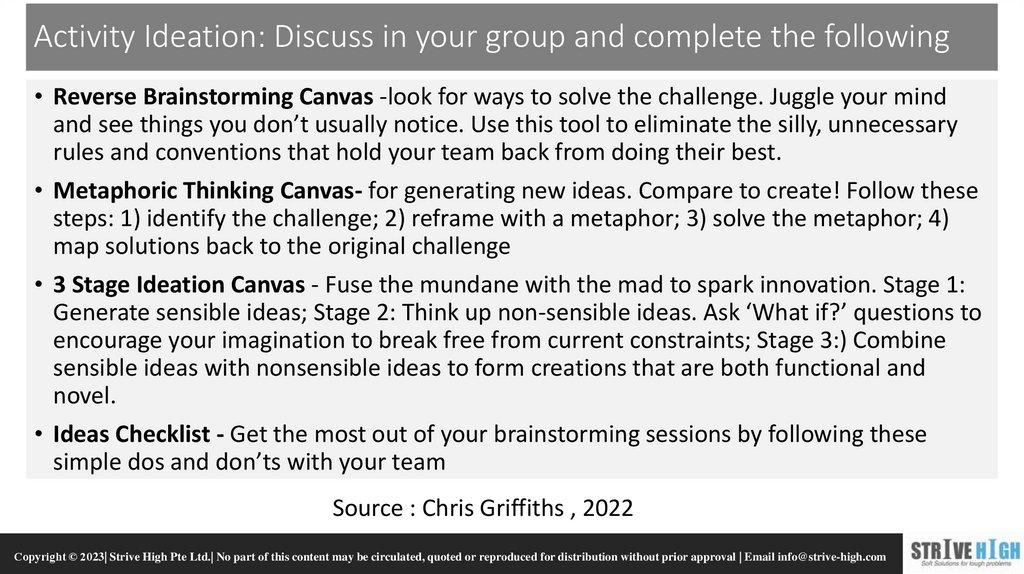



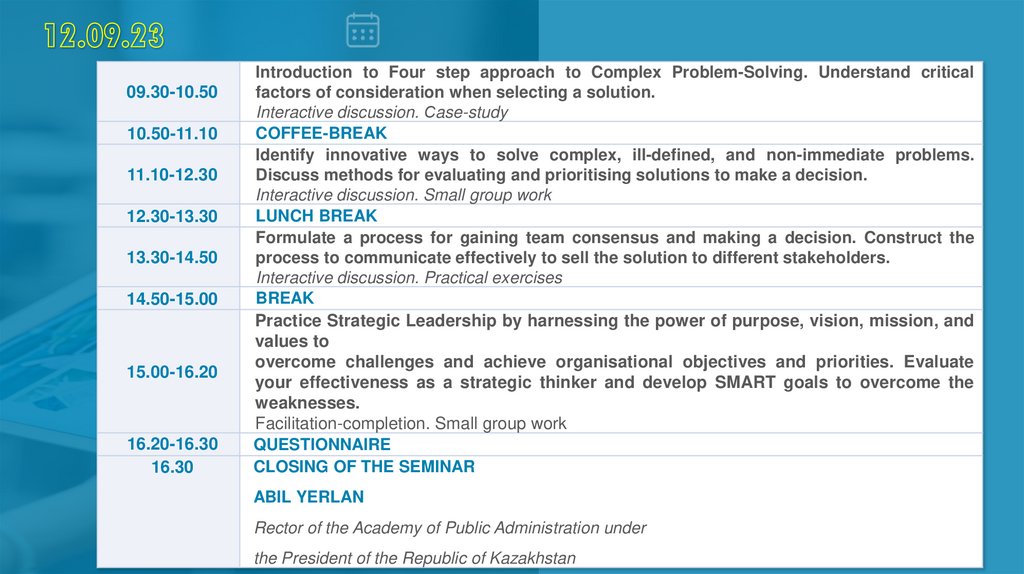
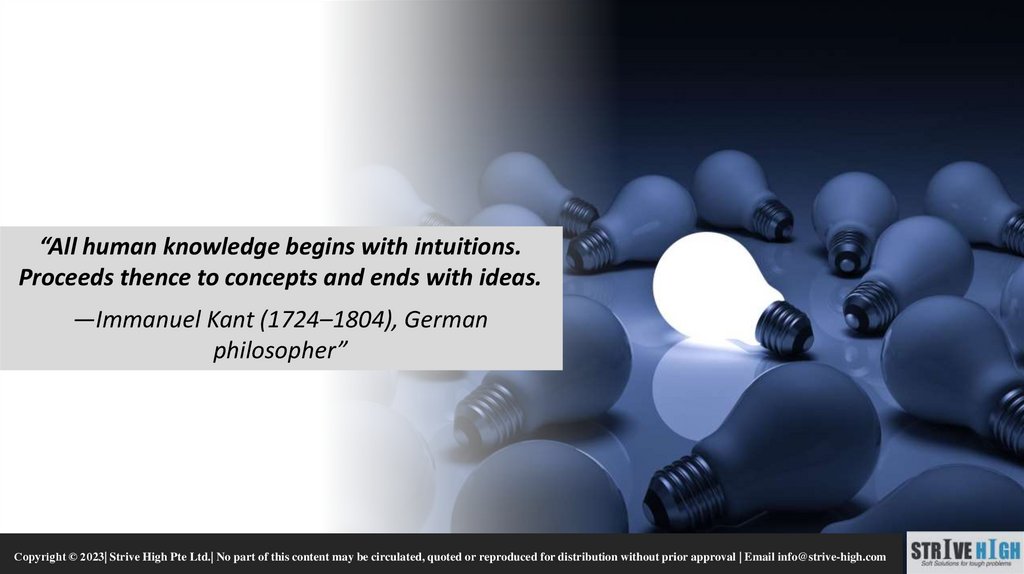
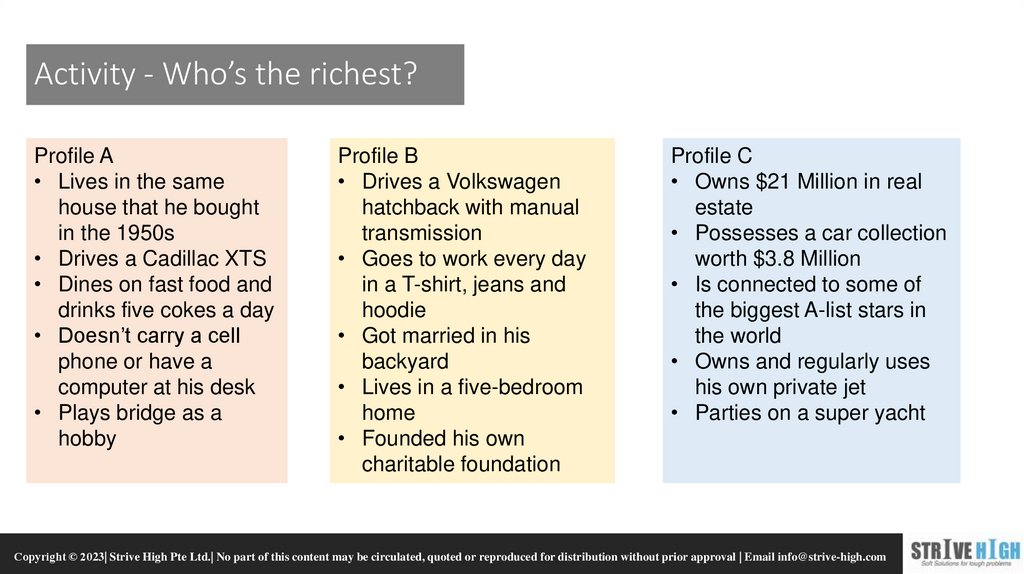
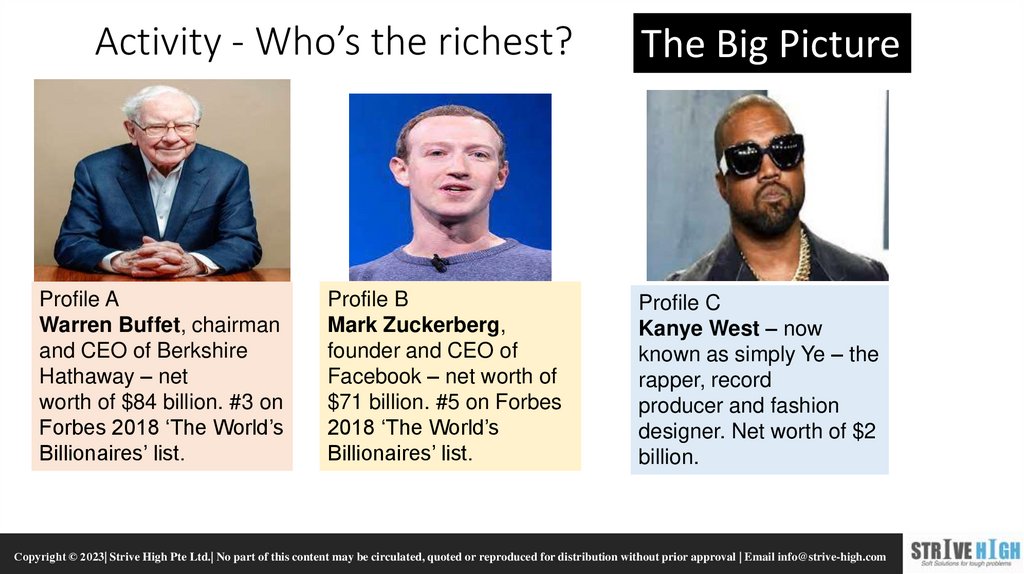


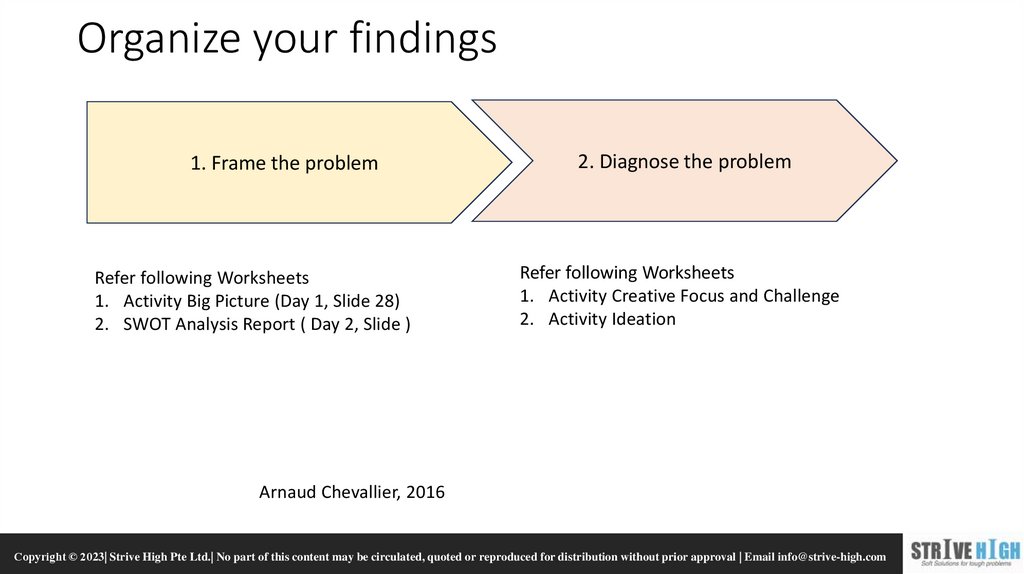
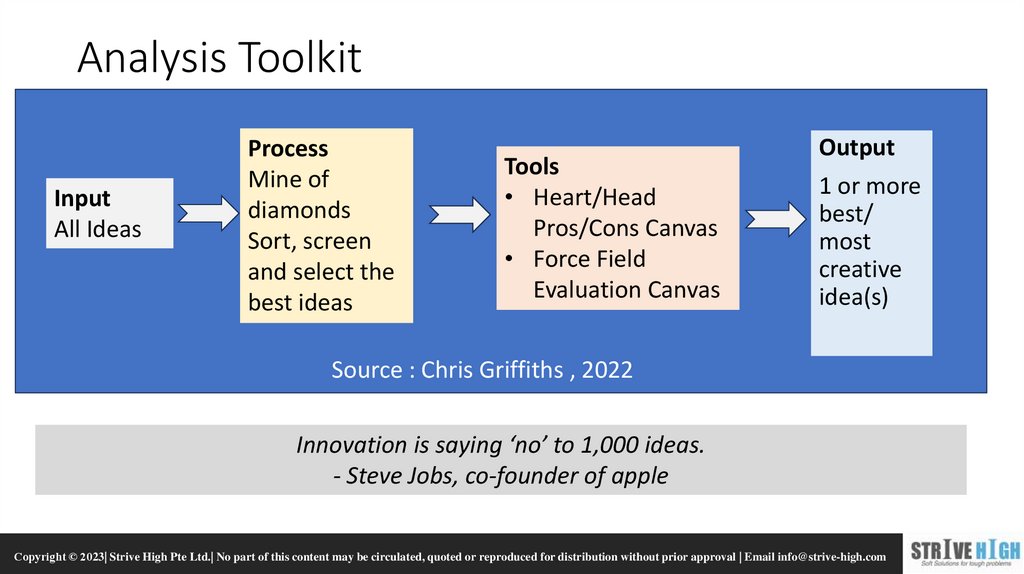





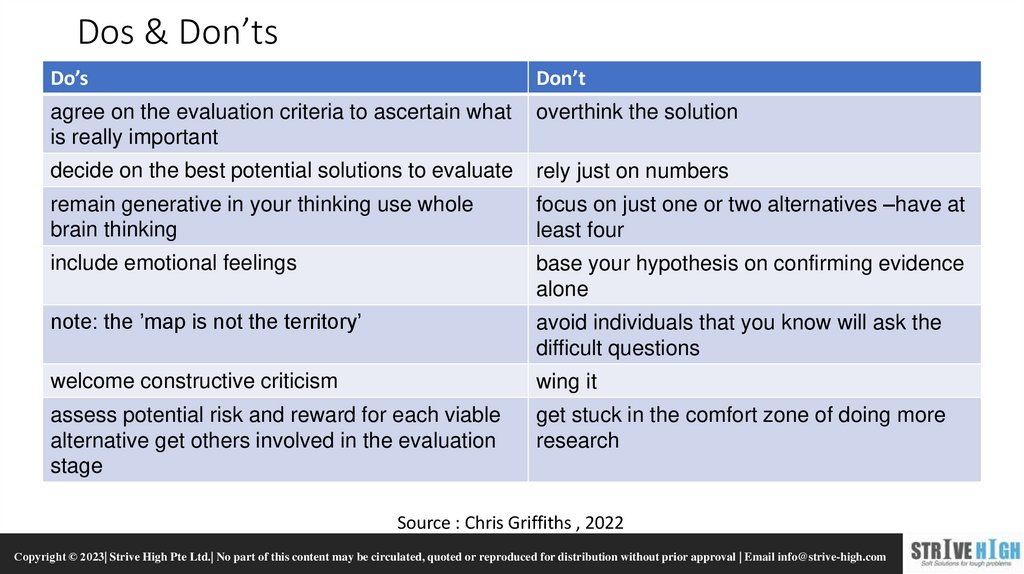



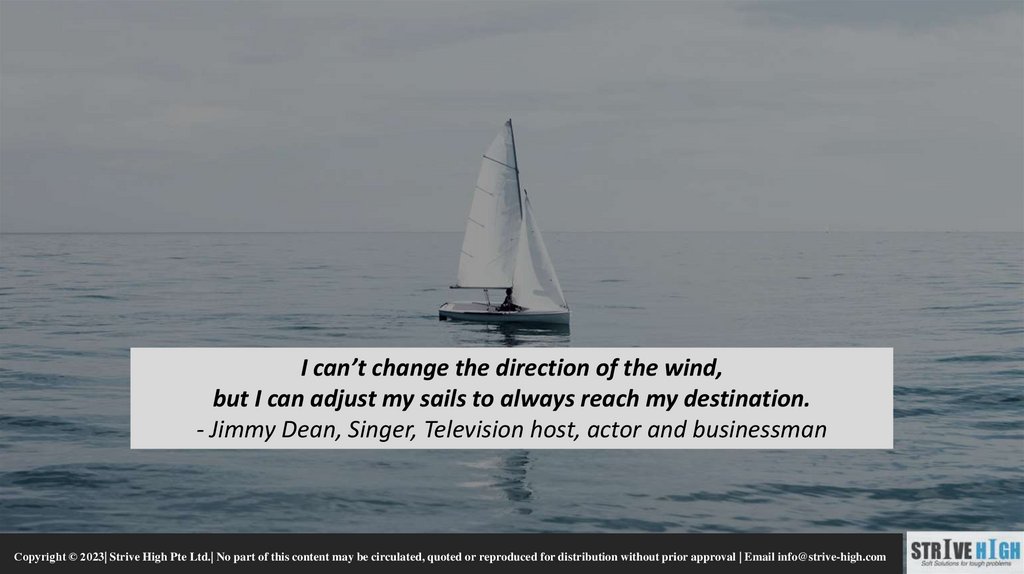


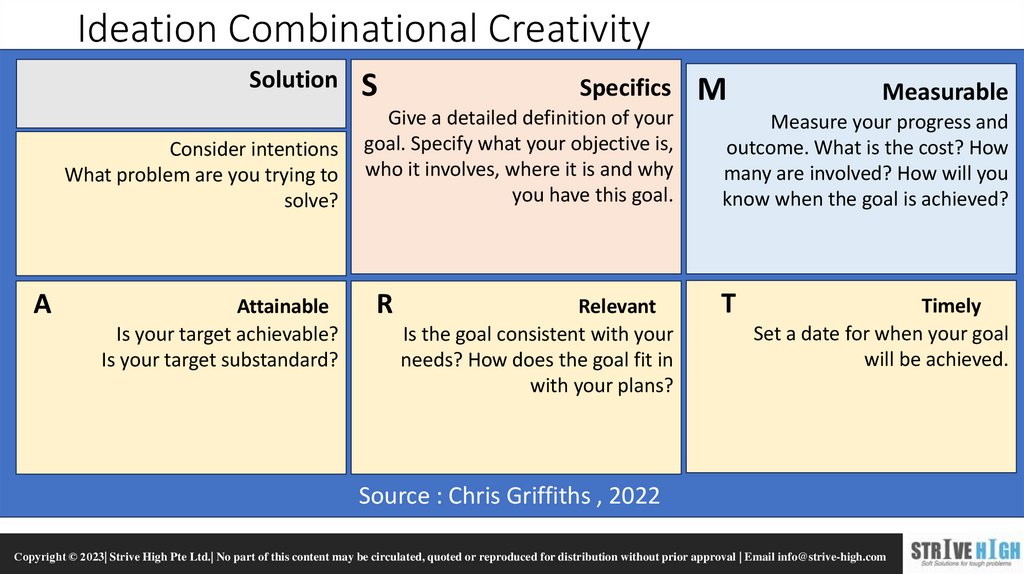
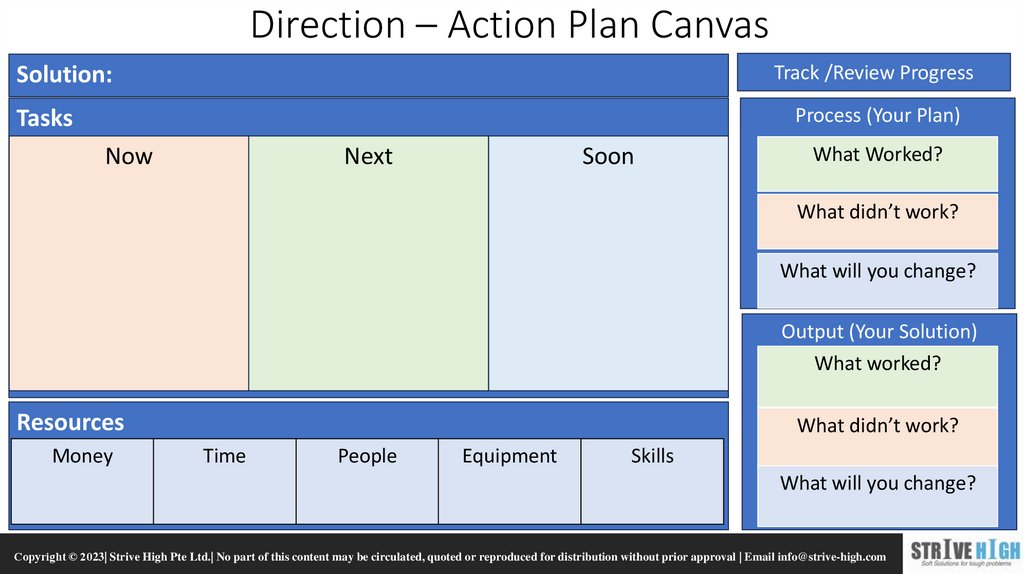
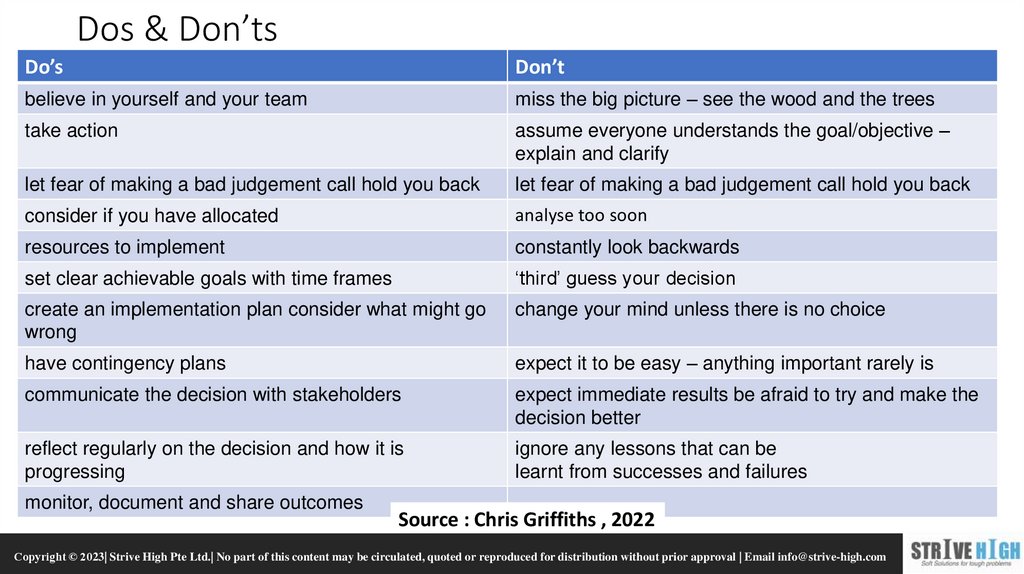

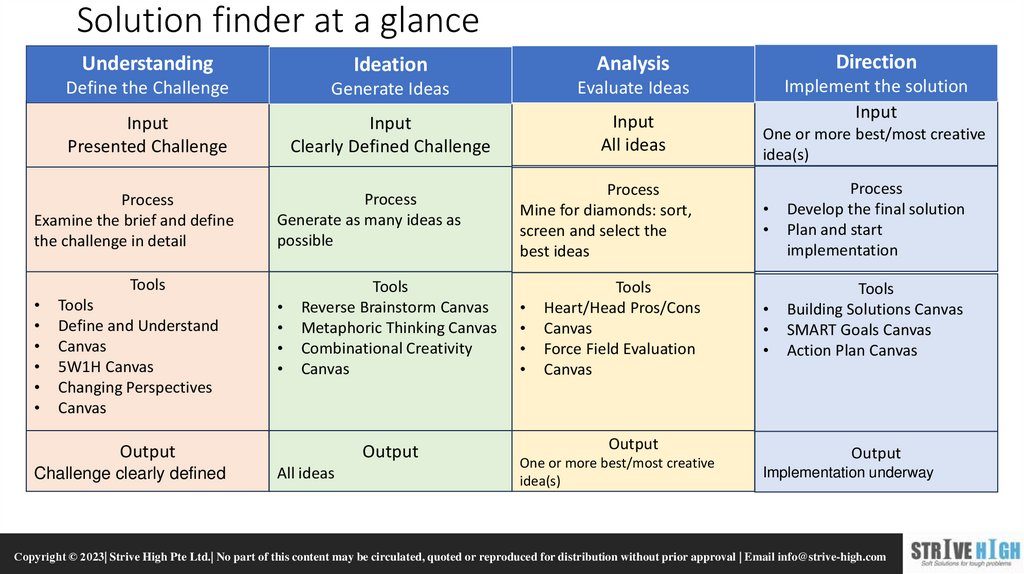

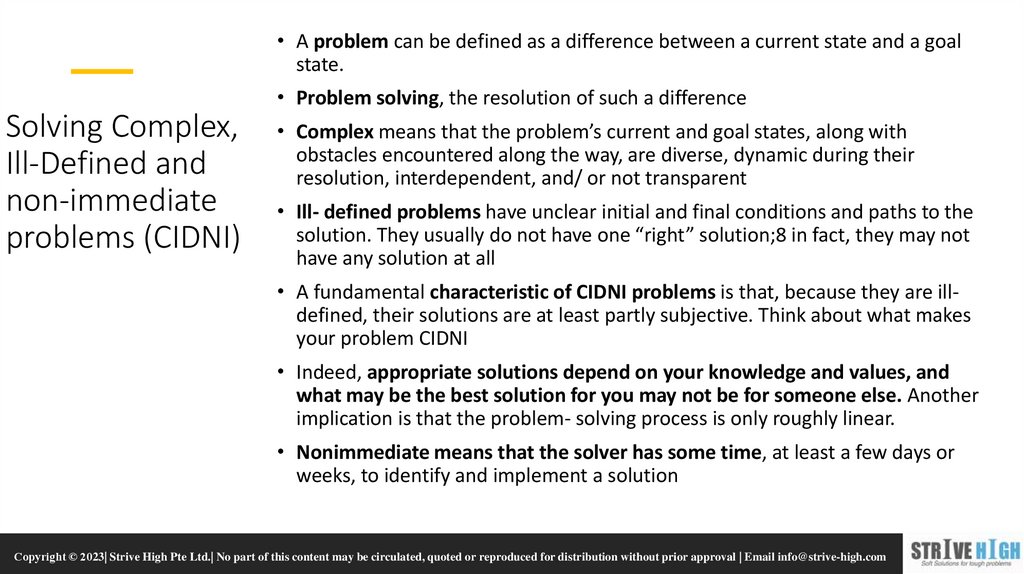
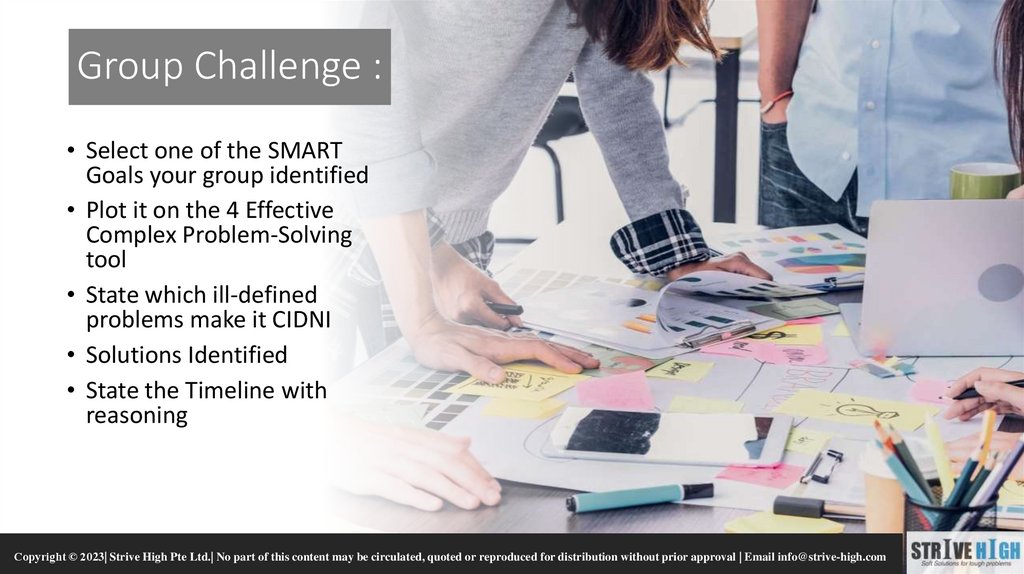
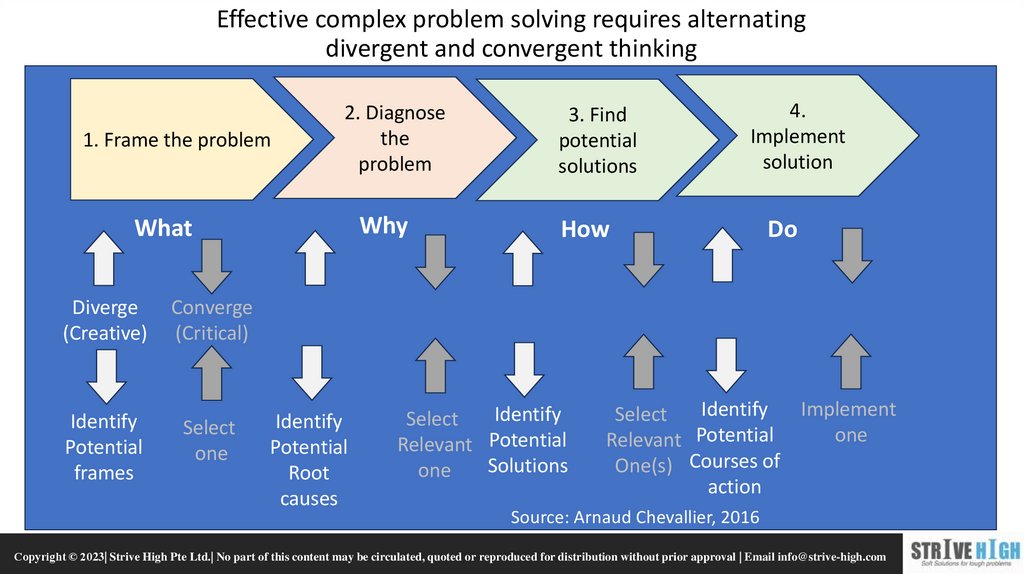


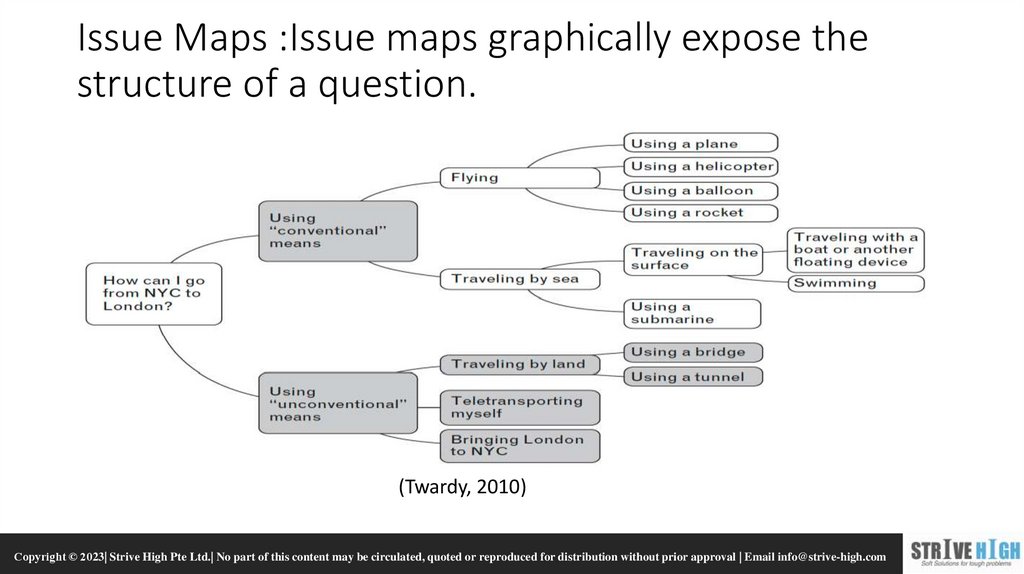




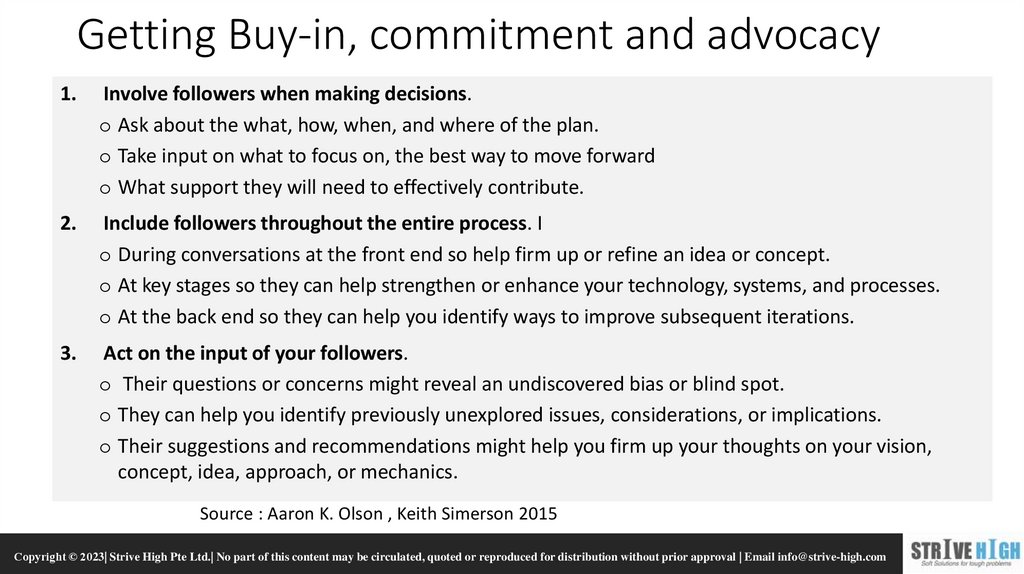
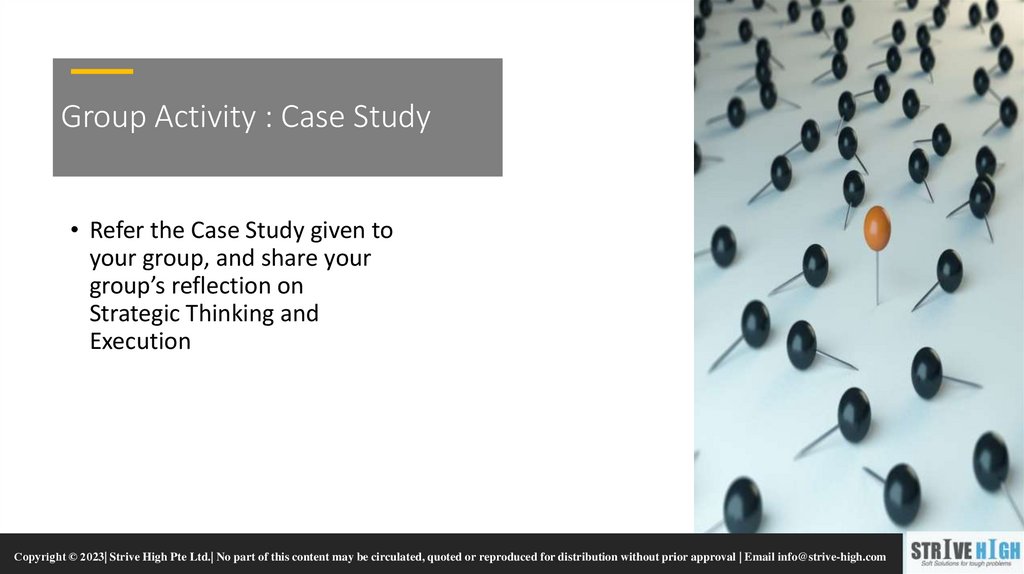
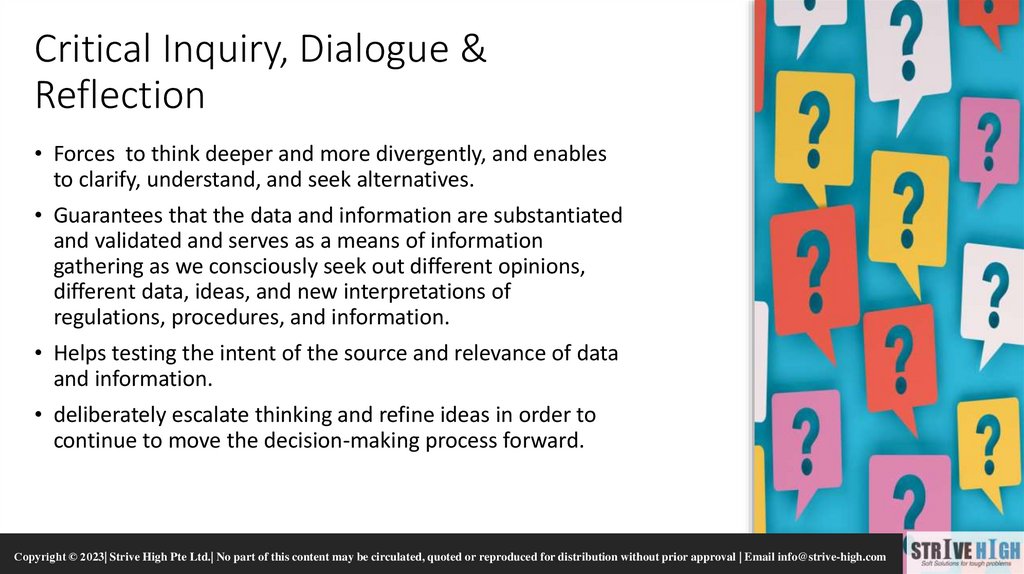


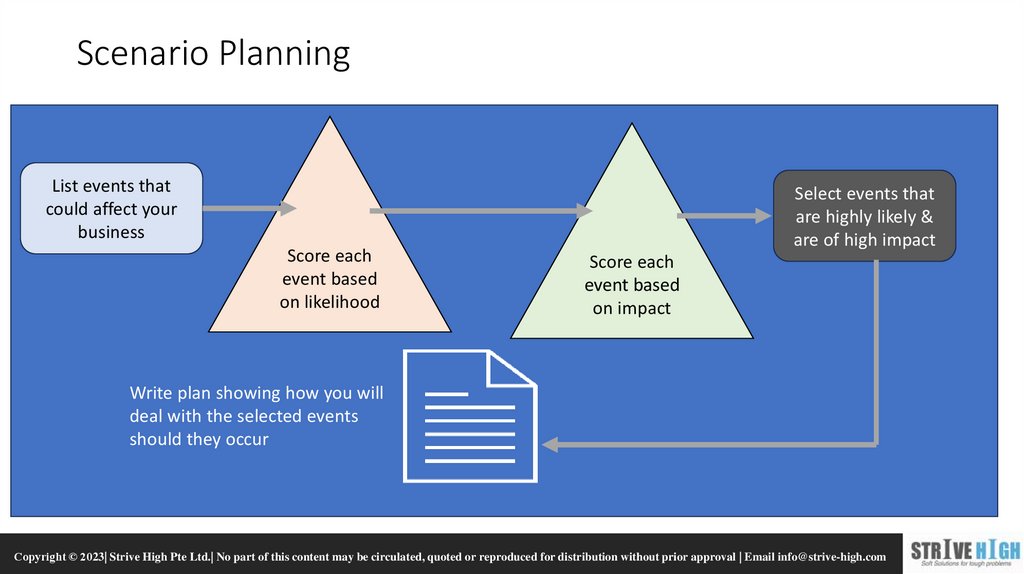



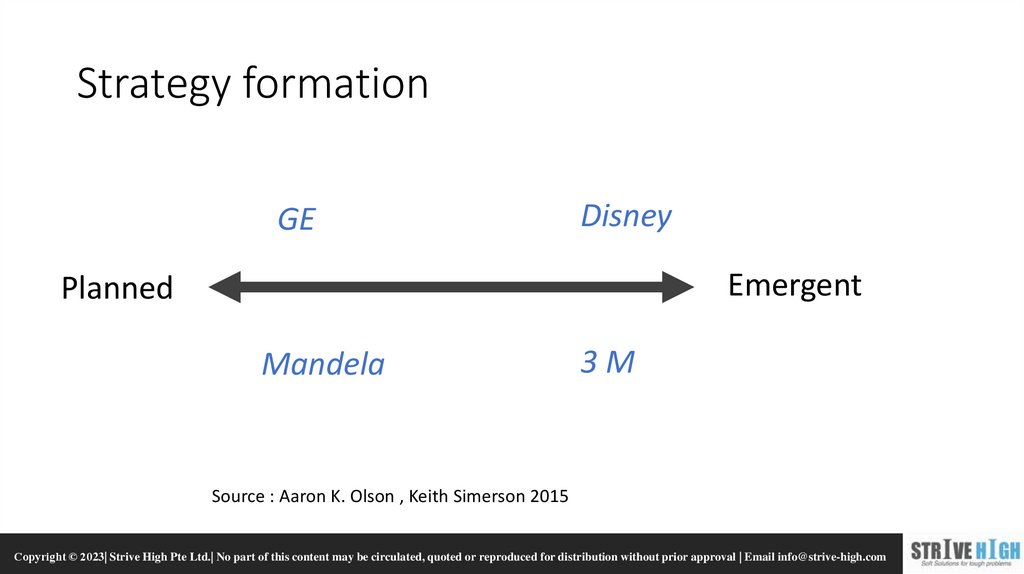

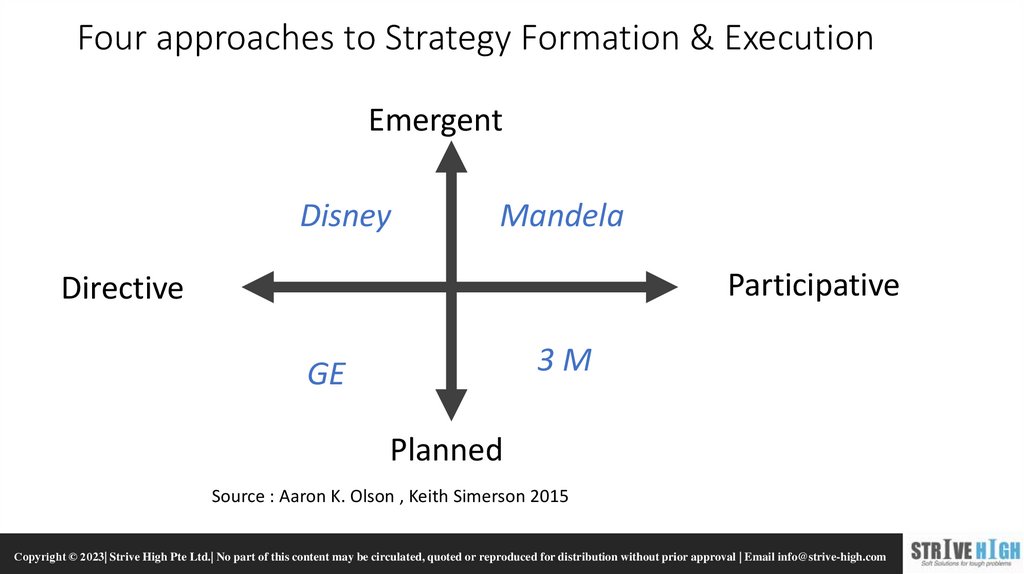
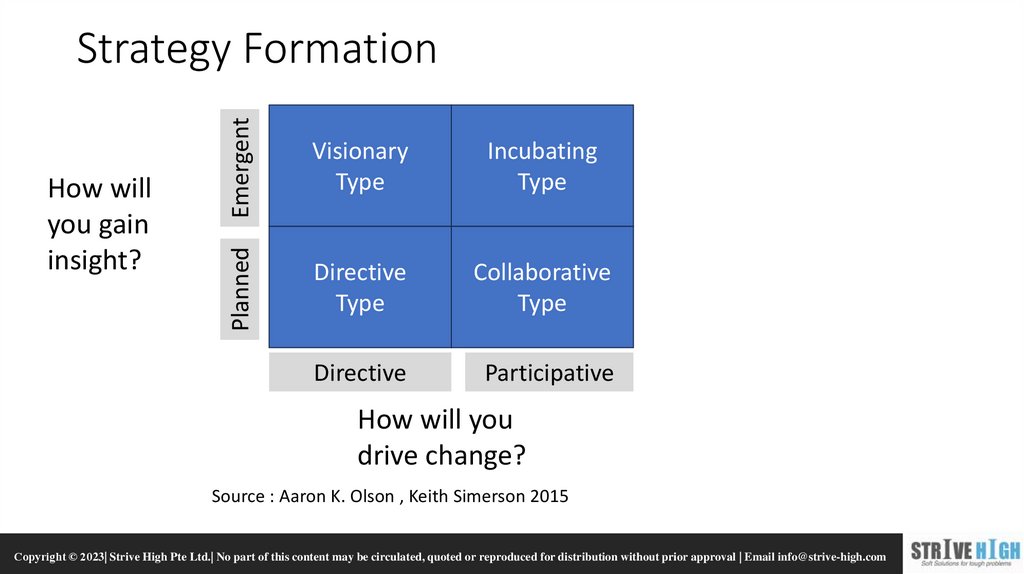

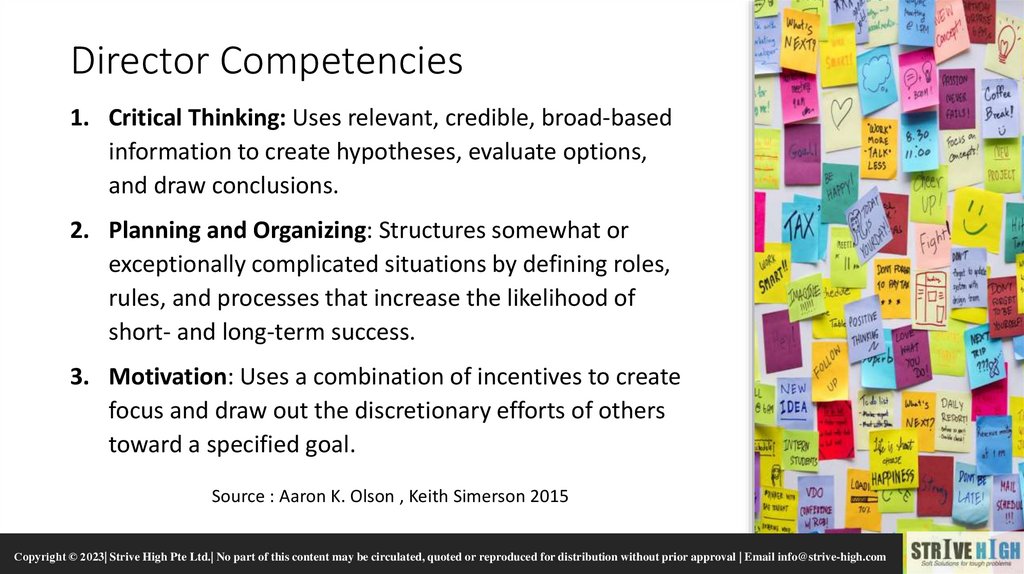



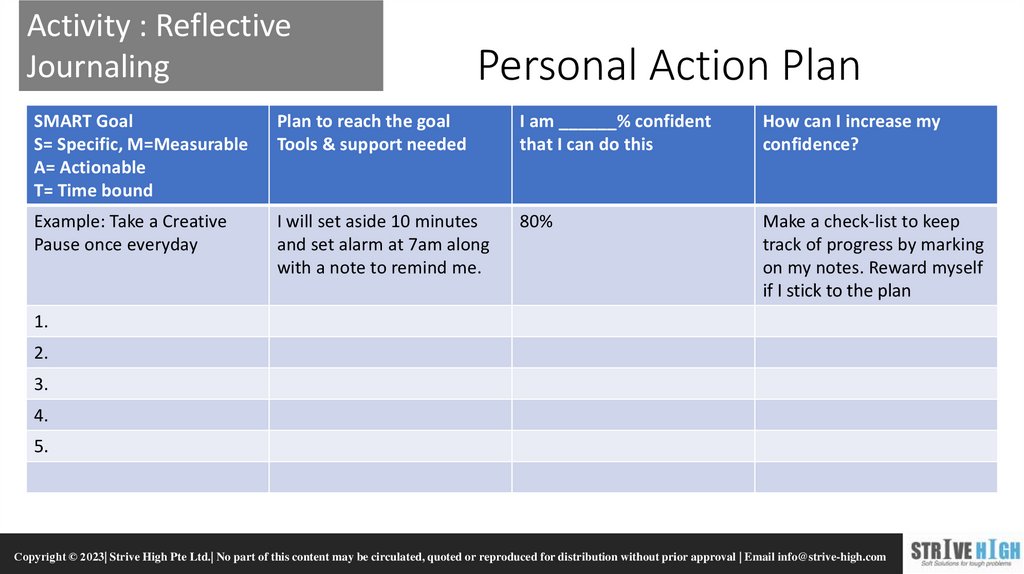

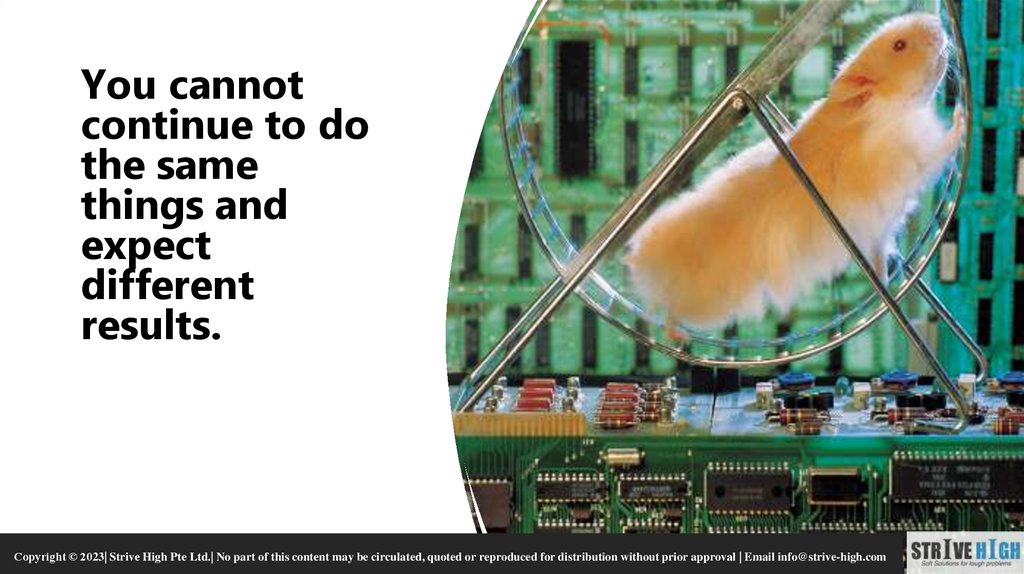
 management
management








